:max_bytes(150000):strip_icc():format(webp)/how-to-choose-your-ideal-phonecase-ca91460721b143b0b0ae61b5baf11b3c.jpg)
Learn Everything About Leeming LUT Pro

Learn Everything About Leeming LUT Pro
Create High-Quality Video - Wondershare Filmora
An easy and powerful YouTube video editor
Numerous video and audio effects to choose from
Detailed tutorials are provided by the official channel
Color grading can be a tedious process, especially if you don’t have the technical skills required to achieve the desired result. That’s where a LUT can come in handy. So, what is a LUT?
LUT stands for “look up table.” Simply put, a LUT is a color preset that you can apply to your video footage to speed up the color grading process. While LUTs are commonly used to speed up the color grading process, they can also be used for other tasks, such as color transfer between software, monitor calibration, and more.
In this article, we’ll explore a particular LUT – Leeming LUT Pro™ and how you can use it in various video editors.
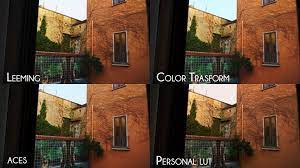
In this article
02 Supported Cameras of Leeming LUT Pro™
03 How to Import and Use Leeming LUT Pro™ in Different Video Editors
What is Leeming LUT Pro™?
Leeming LUT Pro™ is the world’s first unified, corrective Look Up Table (LUT) system for supported cameras. It’s designed to maximize dynamic range, fix skin tones, remove unwanted color casts and provide an accurate Rec709 starting point for further creative color grading.
The Pro LUTs are designed for perfect Rec709 colorimetry and have a linear luma curve, with an average measured dE(2000) of less than 1. As a result, they are visually indistinguishable from reality to the human eye.
Athena LUTs are a brighter version of Pro. They are designed around how the eye sees while retaining the same perfect colorimetry as Pro.
Supported Cameras of Leeming LUT Pro™
- Panasonic G Series: All G series cameras with Cine-D, V-LogL, and HLG for Rec709
- Panasonic S Series: All S series cameras with V-Log, V-Log BRAW, V-Log ProRes RAW, Cine-D, Cine-D2, and HLG for Rec709
- Fujifilm X Series: All X Series cameras with F-Log, Eterna Cinema, Pro Neg Std, and HLG for Rec709
- Canon R Series: All R series cameras with the Faithful Picture Style, C-Log, C-Log3, and CanonRAW
- Canon C Series: All C series cameras with BT.709, C-Log2, C-Log3, HDR-PQ for Rec709, and HLG for Rec709
- Blackmagic Pocket 4K/6K/6K Pro: All cameras with Gen 4 or Gen5 Film
- Blackmagic Pocket/Micro: Older cameras with Gen1 Film
- Nikon Z Series: All cameras with N-Log, Flat
- Sony A Series: All cameras with Picture profile menus, like the A7, with Cine2, S-Log2, S-Log3, HLG/3 for Rec709, and S-Cinetone
- JVC: GY-LS300 with J-Log1
- RunCam: 5 Orange Normal, Flat
- GoPro: 6,7 8, 9 & 10 ProTune, 4 & 5 ProTune, Session ProTune
- DJI: Mavic3, Phantom 4 Pro, Air 2S, Mavic 2 Pro, Mavic Air 2, Mini Series, Mavic Air, Mavic Pro, Pocket 2, Osmo Pocket, Osmo Action, X5 Series
How to Import and Use Leeming LUT Pro™ in Different Video Editors
Leeming LUT Pro™ is supported by various video editors, coloring software, and motion graphics programs, such as:
- Final Cut Pro X
- Avid Media Composer
- DaVinci Resolve
- Adobe Premiere Pro
- Adobe After Effects
- Magix Vegas
- Grass Valley Edius
- Lightworks
- Cyberlink PowerDirector
- LumaFusion
Next, we’ll explore how you can use Leeming LUT in some popular video editors.
1. How to Use Leeming LUT in FCPX
Follow these steps to use Leeming LUT in Final Cut Pro:
Step 1. Import Footage
Launch Final Cut Pro and import your footage. To import your footage, navigate to the top left corner and click on the import icon (the arrow pointing downwards).
In the window that opens, your camera or device name should appear in the left column under devices.
Click on your camera or device to display the media you want to import. Then select the media you want to import and click on the import selected button in the bottom right corner to import your footage.
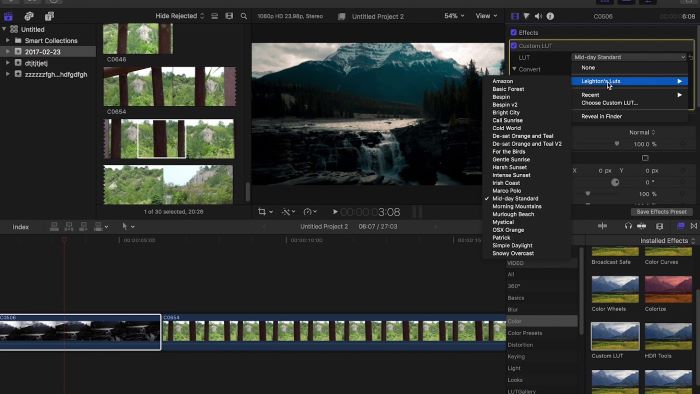
Step 2. Highlight the Footage
Highlight all the footage by clicking and dragging your pointer over the footage or press Command + A to select all the footage.

Step 3. Open the Inspector
After highlighting all the footage, open the Inspector menu and click the little i icon. Then go down to the bottom of the Inspector and switch from Basic to General.
Step 4. Select the Camera LUT Option
Select Camera LUT from the options under General and click on the Add Custom Camera LUT option.
Step 5. Import Leeming LUTs into FCPX
Find the folder where your Leeming LUTs are stored and import them into Final Cut Pro by clicking on Open.
Step 6. Select the LUT
Once imported, go back to the Camera LUT option under General and click on it. Then scroll down the available options and select your Leeming LUT under the Custom Camera options.
Finally, click the profile you used to apply it to your footage.
2. How to Use Leeming LUT in PowerDirector
Follow these steps to use a LUT in PowerDirector:
Step 1. Launch PowerDirector
Open PowerDirector and select Full Mode.
Step 2. Import Media
Click the import button and then select Import Media Folder to import the video footage you want to apply the Leeming LUT to.
Step 3. Add Footage to Timeline
Drag and drop the imported video footage into your project’s timeline.
Step 4. Select the Fix/Enhance Option
Click on the video clip on the timeline and choose the Fix/Enhance option.
Step 5. Select the Color Presets & CLUTs Option
In the top left window that opens above the timeline, select the Color Presets & CLUTs option under Enhance.
Step 6. Apply the Leeming LUT to the Footage
Click on the import button in the panel to import the Leeming LUT file. Once imported, apply it to give your video a more vibrant look.
Part 5: Bonus! Use Filmora – Easy to Use Video Editor for Color LUTs
Besides Final Cut Pro and PowerDirector, Filmora is another excellent video editing software that you can use to apply LUTs to your video.
Designed for beginners and intermediate users, Filmora is an intuitive yet powerful video editing software.
For instance, you can apply 3D LUTs to your video using Filmora. Unlike 1D LUTs, which can only control one value setting, 3D LUTs can allow you to control various value settings. As a result, 3D LUTs can give you more control over specific color values in your video.
Here’s how you can apply LUTs using Filmora:
Step 1. Import the Footage
Launch Filmora and choose New Project. In the New Project window that opens, import the video you want to apply the LUT to by clicking on Import and selecting one of the drop-down options.
Step 2. Add the Video to the Timeline
Drag and drop the video into your project’s timeline.
Step 3. Open the Color Tab
Double click the video on the timeline to select it. Once it’s selected, go to the top left panel and click on the color tab.
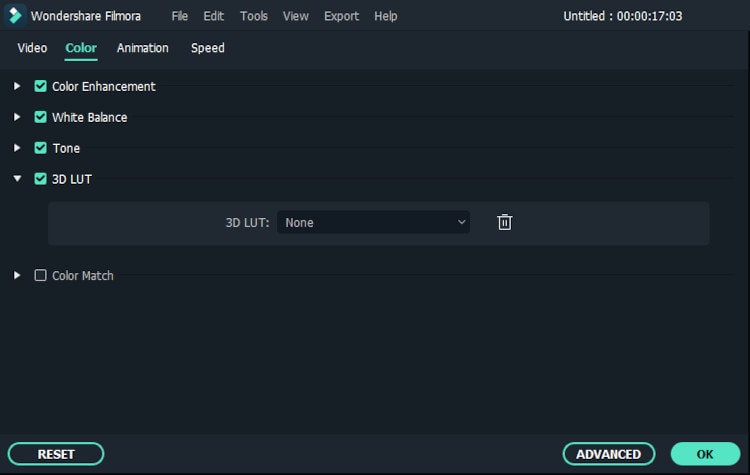
Step 4. Apply a LUT to the Video
Under the color tab, navigate to the 3D LUT option and select one of the available options in the 3D LUT drop-down menu to apply a LUT.
Many LUTs are named after popular TV shows and series whose visual styles they mimic, such as Batman, House of Cards, Game of Thrones, Mission Impossible, Harry Potter, Star Wars, and more.
Once you apply a LUT, you can see your changes in the Preview Window. Besides using the preset LUTs, Filmora also allows you to use custom LUTs. Instead of choosing one of the presets, click on the Load New LUT option to import your custom LUT into Filmora.
Step 5. Make Fine Adjustments
Once you apply a LUT, Filmora can allow you to make further modifications to the video. Click on the Advanced button at the bottom of the color tab to view advanced color correction options.
In the new window that opens, you can adjust several things, such as color, light, HSL, and more. You can also choose from a variety of other available presets.
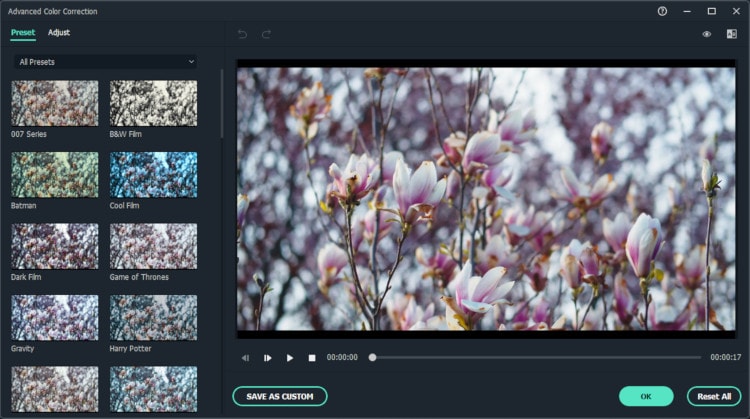
Step 6. Save the Changes
Once you’re satisfied with the changes you’ve applied, click on the OK button in the lower right corner to save the changes.
For Win 7 or later (64-bit)
For macOS 10.12 or later
Conclusion
LUTs are a fast way to color grade your footage after color correction. However, to ensure your LUTs work effectively, here are some important guidelines you should observe when using LUTs:
- Ensure your footage matches from shot to shot, especially if you’re applying LUTs to multiple clips.
- Ensure your exposure is correct before using LUTs. You can use a histogram to help you set the exposure.
- Ensure you apply LUTs to a video that’s been properly color corrected.
- Make small adjustments to things, such as brightness, saturation, contrast, exposure, color temperature, and tint for best results.
- Test out various LUTs before settling for one because shooting conditions can drastically affect how different LUTs look.
Ultimately, LUTs are an excellent way to make your video more cinematic. If you don’t have advanced video editing skills or prior experience working with LUTs, don’t worry. Filmora is a user-friendly video editing software that allows you to quickly apply LUTs with no video editing experience. Just download Filmora for free to get started.
Color grading can be a tedious process, especially if you don’t have the technical skills required to achieve the desired result. That’s where a LUT can come in handy. So, what is a LUT?
LUT stands for “look up table.” Simply put, a LUT is a color preset that you can apply to your video footage to speed up the color grading process. While LUTs are commonly used to speed up the color grading process, they can also be used for other tasks, such as color transfer between software, monitor calibration, and more.
In this article, we’ll explore a particular LUT – Leeming LUT Pro™ and how you can use it in various video editors.

In this article
02 Supported Cameras of Leeming LUT Pro™
03 How to Import and Use Leeming LUT Pro™ in Different Video Editors
What is Leeming LUT Pro™?
Leeming LUT Pro™ is the world’s first unified, corrective Look Up Table (LUT) system for supported cameras. It’s designed to maximize dynamic range, fix skin tones, remove unwanted color casts and provide an accurate Rec709 starting point for further creative color grading.
The Pro LUTs are designed for perfect Rec709 colorimetry and have a linear luma curve, with an average measured dE(2000) of less than 1. As a result, they are visually indistinguishable from reality to the human eye.
Athena LUTs are a brighter version of Pro. They are designed around how the eye sees while retaining the same perfect colorimetry as Pro.
Supported Cameras of Leeming LUT Pro™
- Panasonic G Series: All G series cameras with Cine-D, V-LogL, and HLG for Rec709
- Panasonic S Series: All S series cameras with V-Log, V-Log BRAW, V-Log ProRes RAW, Cine-D, Cine-D2, and HLG for Rec709
- Fujifilm X Series: All X Series cameras with F-Log, Eterna Cinema, Pro Neg Std, and HLG for Rec709
- Canon R Series: All R series cameras with the Faithful Picture Style, C-Log, C-Log3, and CanonRAW
- Canon C Series: All C series cameras with BT.709, C-Log2, C-Log3, HDR-PQ for Rec709, and HLG for Rec709
- Blackmagic Pocket 4K/6K/6K Pro: All cameras with Gen 4 or Gen5 Film
- Blackmagic Pocket/Micro: Older cameras with Gen1 Film
- Nikon Z Series: All cameras with N-Log, Flat
- Sony A Series: All cameras with Picture profile menus, like the A7, with Cine2, S-Log2, S-Log3, HLG/3 for Rec709, and S-Cinetone
- JVC: GY-LS300 with J-Log1
- RunCam: 5 Orange Normal, Flat
- GoPro: 6,7 8, 9 & 10 ProTune, 4 & 5 ProTune, Session ProTune
- DJI: Mavic3, Phantom 4 Pro, Air 2S, Mavic 2 Pro, Mavic Air 2, Mini Series, Mavic Air, Mavic Pro, Pocket 2, Osmo Pocket, Osmo Action, X5 Series
How to Import and Use Leeming LUT Pro™ in Different Video Editors
Leeming LUT Pro™ is supported by various video editors, coloring software, and motion graphics programs, such as:
- Final Cut Pro X
- Avid Media Composer
- DaVinci Resolve
- Adobe Premiere Pro
- Adobe After Effects
- Magix Vegas
- Grass Valley Edius
- Lightworks
- Cyberlink PowerDirector
- LumaFusion
Next, we’ll explore how you can use Leeming LUT in some popular video editors.
1. How to Use Leeming LUT in FCPX
Follow these steps to use Leeming LUT in Final Cut Pro:
Step 1. Import Footage
Launch Final Cut Pro and import your footage. To import your footage, navigate to the top left corner and click on the import icon (the arrow pointing downwards).
In the window that opens, your camera or device name should appear in the left column under devices.
Click on your camera or device to display the media you want to import. Then select the media you want to import and click on the import selected button in the bottom right corner to import your footage.

Step 2. Highlight the Footage
Highlight all the footage by clicking and dragging your pointer over the footage or press Command + A to select all the footage.

Step 3. Open the Inspector
After highlighting all the footage, open the Inspector menu and click the little i icon. Then go down to the bottom of the Inspector and switch from Basic to General.
Step 4. Select the Camera LUT Option
Select Camera LUT from the options under General and click on the Add Custom Camera LUT option.
Step 5. Import Leeming LUTs into FCPX
Find the folder where your Leeming LUTs are stored and import them into Final Cut Pro by clicking on Open.
Step 6. Select the LUT
Once imported, go back to the Camera LUT option under General and click on it. Then scroll down the available options and select your Leeming LUT under the Custom Camera options.
Finally, click the profile you used to apply it to your footage.
2. How to Use Leeming LUT in PowerDirector
Follow these steps to use a LUT in PowerDirector:
Step 1. Launch PowerDirector
Open PowerDirector and select Full Mode.
Step 2. Import Media
Click the import button and then select Import Media Folder to import the video footage you want to apply the Leeming LUT to.
Step 3. Add Footage to Timeline
Drag and drop the imported video footage into your project’s timeline.
Step 4. Select the Fix/Enhance Option
Click on the video clip on the timeline and choose the Fix/Enhance option.
Step 5. Select the Color Presets & CLUTs Option
In the top left window that opens above the timeline, select the Color Presets & CLUTs option under Enhance.
Step 6. Apply the Leeming LUT to the Footage
Click on the import button in the panel to import the Leeming LUT file. Once imported, apply it to give your video a more vibrant look.
Part 5: Bonus! Use Filmora – Easy to Use Video Editor for Color LUTs
Besides Final Cut Pro and PowerDirector, Filmora is another excellent video editing software that you can use to apply LUTs to your video.
Designed for beginners and intermediate users, Filmora is an intuitive yet powerful video editing software.
For instance, you can apply 3D LUTs to your video using Filmora. Unlike 1D LUTs, which can only control one value setting, 3D LUTs can allow you to control various value settings. As a result, 3D LUTs can give you more control over specific color values in your video.
Here’s how you can apply LUTs using Filmora:
Step 1. Import the Footage
Launch Filmora and choose New Project. In the New Project window that opens, import the video you want to apply the LUT to by clicking on Import and selecting one of the drop-down options.
Step 2. Add the Video to the Timeline
Drag and drop the video into your project’s timeline.
Step 3. Open the Color Tab
Double click the video on the timeline to select it. Once it’s selected, go to the top left panel and click on the color tab.

Step 4. Apply a LUT to the Video
Under the color tab, navigate to the 3D LUT option and select one of the available options in the 3D LUT drop-down menu to apply a LUT.
Many LUTs are named after popular TV shows and series whose visual styles they mimic, such as Batman, House of Cards, Game of Thrones, Mission Impossible, Harry Potter, Star Wars, and more.
Once you apply a LUT, you can see your changes in the Preview Window. Besides using the preset LUTs, Filmora also allows you to use custom LUTs. Instead of choosing one of the presets, click on the Load New LUT option to import your custom LUT into Filmora.
Step 5. Make Fine Adjustments
Once you apply a LUT, Filmora can allow you to make further modifications to the video. Click on the Advanced button at the bottom of the color tab to view advanced color correction options.
In the new window that opens, you can adjust several things, such as color, light, HSL, and more. You can also choose from a variety of other available presets.

Step 6. Save the Changes
Once you’re satisfied with the changes you’ve applied, click on the OK button in the lower right corner to save the changes.
For Win 7 or later (64-bit)
For macOS 10.12 or later
Conclusion
LUTs are a fast way to color grade your footage after color correction. However, to ensure your LUTs work effectively, here are some important guidelines you should observe when using LUTs:
- Ensure your footage matches from shot to shot, especially if you’re applying LUTs to multiple clips.
- Ensure your exposure is correct before using LUTs. You can use a histogram to help you set the exposure.
- Ensure you apply LUTs to a video that’s been properly color corrected.
- Make small adjustments to things, such as brightness, saturation, contrast, exposure, color temperature, and tint for best results.
- Test out various LUTs before settling for one because shooting conditions can drastically affect how different LUTs look.
Ultimately, LUTs are an excellent way to make your video more cinematic. If you don’t have advanced video editing skills or prior experience working with LUTs, don’t worry. Filmora is a user-friendly video editing software that allows you to quickly apply LUTs with no video editing experience. Just download Filmora for free to get started.
Color grading can be a tedious process, especially if you don’t have the technical skills required to achieve the desired result. That’s where a LUT can come in handy. So, what is a LUT?
LUT stands for “look up table.” Simply put, a LUT is a color preset that you can apply to your video footage to speed up the color grading process. While LUTs are commonly used to speed up the color grading process, they can also be used for other tasks, such as color transfer between software, monitor calibration, and more.
In this article, we’ll explore a particular LUT – Leeming LUT Pro™ and how you can use it in various video editors.

In this article
02 Supported Cameras of Leeming LUT Pro™
03 How to Import and Use Leeming LUT Pro™ in Different Video Editors
What is Leeming LUT Pro™?
Leeming LUT Pro™ is the world’s first unified, corrective Look Up Table (LUT) system for supported cameras. It’s designed to maximize dynamic range, fix skin tones, remove unwanted color casts and provide an accurate Rec709 starting point for further creative color grading.
The Pro LUTs are designed for perfect Rec709 colorimetry and have a linear luma curve, with an average measured dE(2000) of less than 1. As a result, they are visually indistinguishable from reality to the human eye.
Athena LUTs are a brighter version of Pro. They are designed around how the eye sees while retaining the same perfect colorimetry as Pro.
Supported Cameras of Leeming LUT Pro™
- Panasonic G Series: All G series cameras with Cine-D, V-LogL, and HLG for Rec709
- Panasonic S Series: All S series cameras with V-Log, V-Log BRAW, V-Log ProRes RAW, Cine-D, Cine-D2, and HLG for Rec709
- Fujifilm X Series: All X Series cameras with F-Log, Eterna Cinema, Pro Neg Std, and HLG for Rec709
- Canon R Series: All R series cameras with the Faithful Picture Style, C-Log, C-Log3, and CanonRAW
- Canon C Series: All C series cameras with BT.709, C-Log2, C-Log3, HDR-PQ for Rec709, and HLG for Rec709
- Blackmagic Pocket 4K/6K/6K Pro: All cameras with Gen 4 or Gen5 Film
- Blackmagic Pocket/Micro: Older cameras with Gen1 Film
- Nikon Z Series: All cameras with N-Log, Flat
- Sony A Series: All cameras with Picture profile menus, like the A7, with Cine2, S-Log2, S-Log3, HLG/3 for Rec709, and S-Cinetone
- JVC: GY-LS300 with J-Log1
- RunCam: 5 Orange Normal, Flat
- GoPro: 6,7 8, 9 & 10 ProTune, 4 & 5 ProTune, Session ProTune
- DJI: Mavic3, Phantom 4 Pro, Air 2S, Mavic 2 Pro, Mavic Air 2, Mini Series, Mavic Air, Mavic Pro, Pocket 2, Osmo Pocket, Osmo Action, X5 Series
How to Import and Use Leeming LUT Pro™ in Different Video Editors
Leeming LUT Pro™ is supported by various video editors, coloring software, and motion graphics programs, such as:
- Final Cut Pro X
- Avid Media Composer
- DaVinci Resolve
- Adobe Premiere Pro
- Adobe After Effects
- Magix Vegas
- Grass Valley Edius
- Lightworks
- Cyberlink PowerDirector
- LumaFusion
Next, we’ll explore how you can use Leeming LUT in some popular video editors.
1. How to Use Leeming LUT in FCPX
Follow these steps to use Leeming LUT in Final Cut Pro:
Step 1. Import Footage
Launch Final Cut Pro and import your footage. To import your footage, navigate to the top left corner and click on the import icon (the arrow pointing downwards).
In the window that opens, your camera or device name should appear in the left column under devices.
Click on your camera or device to display the media you want to import. Then select the media you want to import and click on the import selected button in the bottom right corner to import your footage.

Step 2. Highlight the Footage
Highlight all the footage by clicking and dragging your pointer over the footage or press Command + A to select all the footage.

Step 3. Open the Inspector
After highlighting all the footage, open the Inspector menu and click the little i icon. Then go down to the bottom of the Inspector and switch from Basic to General.
Step 4. Select the Camera LUT Option
Select Camera LUT from the options under General and click on the Add Custom Camera LUT option.
Step 5. Import Leeming LUTs into FCPX
Find the folder where your Leeming LUTs are stored and import them into Final Cut Pro by clicking on Open.
Step 6. Select the LUT
Once imported, go back to the Camera LUT option under General and click on it. Then scroll down the available options and select your Leeming LUT under the Custom Camera options.
Finally, click the profile you used to apply it to your footage.
2. How to Use Leeming LUT in PowerDirector
Follow these steps to use a LUT in PowerDirector:
Step 1. Launch PowerDirector
Open PowerDirector and select Full Mode.
Step 2. Import Media
Click the import button and then select Import Media Folder to import the video footage you want to apply the Leeming LUT to.
Step 3. Add Footage to Timeline
Drag and drop the imported video footage into your project’s timeline.
Step 4. Select the Fix/Enhance Option
Click on the video clip on the timeline and choose the Fix/Enhance option.
Step 5. Select the Color Presets & CLUTs Option
In the top left window that opens above the timeline, select the Color Presets & CLUTs option under Enhance.
Step 6. Apply the Leeming LUT to the Footage
Click on the import button in the panel to import the Leeming LUT file. Once imported, apply it to give your video a more vibrant look.
Part 5: Bonus! Use Filmora – Easy to Use Video Editor for Color LUTs
Besides Final Cut Pro and PowerDirector, Filmora is another excellent video editing software that you can use to apply LUTs to your video.
Designed for beginners and intermediate users, Filmora is an intuitive yet powerful video editing software.
For instance, you can apply 3D LUTs to your video using Filmora. Unlike 1D LUTs, which can only control one value setting, 3D LUTs can allow you to control various value settings. As a result, 3D LUTs can give you more control over specific color values in your video.
Here’s how you can apply LUTs using Filmora:
Step 1. Import the Footage
Launch Filmora and choose New Project. In the New Project window that opens, import the video you want to apply the LUT to by clicking on Import and selecting one of the drop-down options.
Step 2. Add the Video to the Timeline
Drag and drop the video into your project’s timeline.
Step 3. Open the Color Tab
Double click the video on the timeline to select it. Once it’s selected, go to the top left panel and click on the color tab.

Step 4. Apply a LUT to the Video
Under the color tab, navigate to the 3D LUT option and select one of the available options in the 3D LUT drop-down menu to apply a LUT.
Many LUTs are named after popular TV shows and series whose visual styles they mimic, such as Batman, House of Cards, Game of Thrones, Mission Impossible, Harry Potter, Star Wars, and more.
Once you apply a LUT, you can see your changes in the Preview Window. Besides using the preset LUTs, Filmora also allows you to use custom LUTs. Instead of choosing one of the presets, click on the Load New LUT option to import your custom LUT into Filmora.
Step 5. Make Fine Adjustments
Once you apply a LUT, Filmora can allow you to make further modifications to the video. Click on the Advanced button at the bottom of the color tab to view advanced color correction options.
In the new window that opens, you can adjust several things, such as color, light, HSL, and more. You can also choose from a variety of other available presets.

Step 6. Save the Changes
Once you’re satisfied with the changes you’ve applied, click on the OK button in the lower right corner to save the changes.
For Win 7 or later (64-bit)
For macOS 10.12 or later
Conclusion
LUTs are a fast way to color grade your footage after color correction. However, to ensure your LUTs work effectively, here are some important guidelines you should observe when using LUTs:
- Ensure your footage matches from shot to shot, especially if you’re applying LUTs to multiple clips.
- Ensure your exposure is correct before using LUTs. You can use a histogram to help you set the exposure.
- Ensure you apply LUTs to a video that’s been properly color corrected.
- Make small adjustments to things, such as brightness, saturation, contrast, exposure, color temperature, and tint for best results.
- Test out various LUTs before settling for one because shooting conditions can drastically affect how different LUTs look.
Ultimately, LUTs are an excellent way to make your video more cinematic. If you don’t have advanced video editing skills or prior experience working with LUTs, don’t worry. Filmora is a user-friendly video editing software that allows you to quickly apply LUTs with no video editing experience. Just download Filmora for free to get started.
Color grading can be a tedious process, especially if you don’t have the technical skills required to achieve the desired result. That’s where a LUT can come in handy. So, what is a LUT?
LUT stands for “look up table.” Simply put, a LUT is a color preset that you can apply to your video footage to speed up the color grading process. While LUTs are commonly used to speed up the color grading process, they can also be used for other tasks, such as color transfer between software, monitor calibration, and more.
In this article, we’ll explore a particular LUT – Leeming LUT Pro™ and how you can use it in various video editors.

In this article
02 Supported Cameras of Leeming LUT Pro™
03 How to Import and Use Leeming LUT Pro™ in Different Video Editors
What is Leeming LUT Pro™?
Leeming LUT Pro™ is the world’s first unified, corrective Look Up Table (LUT) system for supported cameras. It’s designed to maximize dynamic range, fix skin tones, remove unwanted color casts and provide an accurate Rec709 starting point for further creative color grading.
The Pro LUTs are designed for perfect Rec709 colorimetry and have a linear luma curve, with an average measured dE(2000) of less than 1. As a result, they are visually indistinguishable from reality to the human eye.
Athena LUTs are a brighter version of Pro. They are designed around how the eye sees while retaining the same perfect colorimetry as Pro.
Supported Cameras of Leeming LUT Pro™
- Panasonic G Series: All G series cameras with Cine-D, V-LogL, and HLG for Rec709
- Panasonic S Series: All S series cameras with V-Log, V-Log BRAW, V-Log ProRes RAW, Cine-D, Cine-D2, and HLG for Rec709
- Fujifilm X Series: All X Series cameras with F-Log, Eterna Cinema, Pro Neg Std, and HLG for Rec709
- Canon R Series: All R series cameras with the Faithful Picture Style, C-Log, C-Log3, and CanonRAW
- Canon C Series: All C series cameras with BT.709, C-Log2, C-Log3, HDR-PQ for Rec709, and HLG for Rec709
- Blackmagic Pocket 4K/6K/6K Pro: All cameras with Gen 4 or Gen5 Film
- Blackmagic Pocket/Micro: Older cameras with Gen1 Film
- Nikon Z Series: All cameras with N-Log, Flat
- Sony A Series: All cameras with Picture profile menus, like the A7, with Cine2, S-Log2, S-Log3, HLG/3 for Rec709, and S-Cinetone
- JVC: GY-LS300 with J-Log1
- RunCam: 5 Orange Normal, Flat
- GoPro: 6,7 8, 9 & 10 ProTune, 4 & 5 ProTune, Session ProTune
- DJI: Mavic3, Phantom 4 Pro, Air 2S, Mavic 2 Pro, Mavic Air 2, Mini Series, Mavic Air, Mavic Pro, Pocket 2, Osmo Pocket, Osmo Action, X5 Series
How to Import and Use Leeming LUT Pro™ in Different Video Editors
Leeming LUT Pro™ is supported by various video editors, coloring software, and motion graphics programs, such as:
- Final Cut Pro X
- Avid Media Composer
- DaVinci Resolve
- Adobe Premiere Pro
- Adobe After Effects
- Magix Vegas
- Grass Valley Edius
- Lightworks
- Cyberlink PowerDirector
- LumaFusion
Next, we’ll explore how you can use Leeming LUT in some popular video editors.
1. How to Use Leeming LUT in FCPX
Follow these steps to use Leeming LUT in Final Cut Pro:
Step 1. Import Footage
Launch Final Cut Pro and import your footage. To import your footage, navigate to the top left corner and click on the import icon (the arrow pointing downwards).
In the window that opens, your camera or device name should appear in the left column under devices.
Click on your camera or device to display the media you want to import. Then select the media you want to import and click on the import selected button in the bottom right corner to import your footage.

Step 2. Highlight the Footage
Highlight all the footage by clicking and dragging your pointer over the footage or press Command + A to select all the footage.

Step 3. Open the Inspector
After highlighting all the footage, open the Inspector menu and click the little i icon. Then go down to the bottom of the Inspector and switch from Basic to General.
Step 4. Select the Camera LUT Option
Select Camera LUT from the options under General and click on the Add Custom Camera LUT option.
Step 5. Import Leeming LUTs into FCPX
Find the folder where your Leeming LUTs are stored and import them into Final Cut Pro by clicking on Open.
Step 6. Select the LUT
Once imported, go back to the Camera LUT option under General and click on it. Then scroll down the available options and select your Leeming LUT under the Custom Camera options.
Finally, click the profile you used to apply it to your footage.
2. How to Use Leeming LUT in PowerDirector
Follow these steps to use a LUT in PowerDirector:
Step 1. Launch PowerDirector
Open PowerDirector and select Full Mode.
Step 2. Import Media
Click the import button and then select Import Media Folder to import the video footage you want to apply the Leeming LUT to.
Step 3. Add Footage to Timeline
Drag and drop the imported video footage into your project’s timeline.
Step 4. Select the Fix/Enhance Option
Click on the video clip on the timeline and choose the Fix/Enhance option.
Step 5. Select the Color Presets & CLUTs Option
In the top left window that opens above the timeline, select the Color Presets & CLUTs option under Enhance.
Step 6. Apply the Leeming LUT to the Footage
Click on the import button in the panel to import the Leeming LUT file. Once imported, apply it to give your video a more vibrant look.
Part 5: Bonus! Use Filmora – Easy to Use Video Editor for Color LUTs
Besides Final Cut Pro and PowerDirector, Filmora is another excellent video editing software that you can use to apply LUTs to your video.
Designed for beginners and intermediate users, Filmora is an intuitive yet powerful video editing software.
For instance, you can apply 3D LUTs to your video using Filmora. Unlike 1D LUTs, which can only control one value setting, 3D LUTs can allow you to control various value settings. As a result, 3D LUTs can give you more control over specific color values in your video.
Here’s how you can apply LUTs using Filmora:
Step 1. Import the Footage
Launch Filmora and choose New Project. In the New Project window that opens, import the video you want to apply the LUT to by clicking on Import and selecting one of the drop-down options.
Step 2. Add the Video to the Timeline
Drag and drop the video into your project’s timeline.
Step 3. Open the Color Tab
Double click the video on the timeline to select it. Once it’s selected, go to the top left panel and click on the color tab.

Step 4. Apply a LUT to the Video
Under the color tab, navigate to the 3D LUT option and select one of the available options in the 3D LUT drop-down menu to apply a LUT.
Many LUTs are named after popular TV shows and series whose visual styles they mimic, such as Batman, House of Cards, Game of Thrones, Mission Impossible, Harry Potter, Star Wars, and more.
Once you apply a LUT, you can see your changes in the Preview Window. Besides using the preset LUTs, Filmora also allows you to use custom LUTs. Instead of choosing one of the presets, click on the Load New LUT option to import your custom LUT into Filmora.
Step 5. Make Fine Adjustments
Once you apply a LUT, Filmora can allow you to make further modifications to the video. Click on the Advanced button at the bottom of the color tab to view advanced color correction options.
In the new window that opens, you can adjust several things, such as color, light, HSL, and more. You can also choose from a variety of other available presets.

Step 6. Save the Changes
Once you’re satisfied with the changes you’ve applied, click on the OK button in the lower right corner to save the changes.
For Win 7 or later (64-bit)
For macOS 10.12 or later
Conclusion
LUTs are a fast way to color grade your footage after color correction. However, to ensure your LUTs work effectively, here are some important guidelines you should observe when using LUTs:
- Ensure your footage matches from shot to shot, especially if you’re applying LUTs to multiple clips.
- Ensure your exposure is correct before using LUTs. You can use a histogram to help you set the exposure.
- Ensure you apply LUTs to a video that’s been properly color corrected.
- Make small adjustments to things, such as brightness, saturation, contrast, exposure, color temperature, and tint for best results.
- Test out various LUTs before settling for one because shooting conditions can drastically affect how different LUTs look.
Ultimately, LUTs are an excellent way to make your video more cinematic. If you don’t have advanced video editing skills or prior experience working with LUTs, don’t worry. Filmora is a user-friendly video editing software that allows you to quickly apply LUTs with no video editing experience. Just download Filmora for free to get started.
8 Apps to Custom Your GIF Stickers
8 Apps to Custom Your GIF Stickers
An easy yet powerful editor
Numerous effects to choose from
Detailed tutorials provided by the official channel
GIF files are a new trend, and people are very happy to share them with their loved ones. Undoubtedly, according to the mood, the GIF file is available, and they can send it easily. But how can we forget that the present generation is quite curious to know about the process behind creating it?
If you are someone who is curious to know about the creation of GIF stickers and other related things, then you are on the right page. In this article, you will find out all the details regarding the making of such stickers and how you will be able to customize them as per your needs.
Stay tuned with us till the end because we will also share some of the best applications for custom GIF stickers that will help you. Let’s get started!
In this article
01 [Top 8 Apps to Custom GIF Stickers](#Part 1)
02 [How to Create Own Free Animated Stickers on Social Media?](#Part 2)
Part 1 Top 8 Apps to Custom GIF Stickers
When it comes to creating custom GIF stickers, it is also important to know about the applications that can cater to your needs. We all are aware about the availability of thousands of applications that claim to be the best ones, but relying on them is not easy. Well, in that case, we have come up with some applications that will help you. This includes:
01Gif Me! Camera
GIF Me! camera is an app that can easily generate GIF stickers. It turns photos and videos into GIFs and stickers. You can get a whole library of these stickers to use. This application allows users to create their own GIFs and share them with others on social media channels like Facebook, Instagram, Snapchat, and Twitter.
A user just needs to get the application and, after that, they are all set to create the hot GIF stickers of their choice and share them on different portals.

02Ezgif
Ezgif is a GIF maker that creates animated stickers. This application allows you to create animated GIF stickers from videos and pictures. The user can record a video and then select the part of the video they want to make into a sticker. Also, they can take a picture and turn it into an animated sticker. The stickers are then saved in the app’s library, which can be shared with other users or exported as an animated GIF file.
The stickers that are created can be shared on other portals easily, which simply means there will be no need to get any additional applications to complete the particular task.

03Pixel Animator: GIF Maker
Another good choice that you can make is The Pixel Animator app. This is a great option for those who want to make animated images from their photos. The app allows users to create animations using a timeline. It also has a photo editor that can be used to edit the images before they are converted into GIFs.
It is totally up to the user how they wish to create the GIF. The interface of the application is simple to understand, which clearly means that there will be no problem at all in getting your hands on this application. Also, the created stickers can be shared on other portals, including social media applications too.

04ImgPlay – GIF Maker
ImgPlay is a GIF Maker, an Explain App to create GIF stickers. ImgPlay provides animation effects, stickers, text, and emoji to make an animated video and stickers too. It also has powerful editing features like reverse playback, trimming, and cropping. The ImgPlay app can be used on any device with Android 4.0+ or iOS 9+. But one needs to make sure that initially, this application appears to be difficult to understand, but after getting all the details, this could be one of the simplest applications to use.

05Tumblr
Tumblr is a social media site that is focused on microblogging. Users can post text, photos, videos, quotes, links, and anything else they want. This is an app that allows users to create GIF stickers. By using the app, you can take a video or photo and turn it into a GIF sticker that you can then share on social media sites. This application is majorly under consideration by professionals because it has all the best features integrated into it.
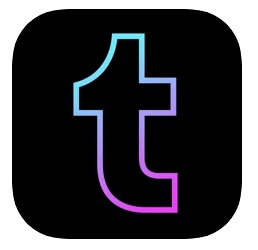
06GIF Toaster
GIF Toaster is a web-based tool that helps you create GIF stickers, which are short looping videos that you can use in your messages. The tool is available at the URL toaster.co. Furthermore, this is a free mobile app that lets you create animated GIFs with just a few taps. After creating the stickers, you are all set to share them on all the portals out there without any problem.

07GIF Maker
GIF Maker is a mobile app that allows users to create GIF stickers from videos and images. Basically, this application is a fun and easy way to communicate with friends and family on social media with the help of available stickers. Simply put, users do not need any emoticons to express what they are feeling.
The created stickers can be easily shared on other portals too. A user just needs to be sure of the destination where they have saved it, and after choosing it, they are all set to use it and share it with their friends over these social media portals.

08GIF Camera
A GIF Camera is a mobile app that takes a series of photos and stitches them together to create a GIF. The app allows users to make their own GIFs or choose from an existing library of animated stickers.
This is a mobile app that uses artificial intelligence to generate animated GIFs from audio or video files. Furthermore, this is used for personal use as well as for business purposes such as marketing and training videos.

Part 2 How to Create Own Free Animated Stickers on Social Media?
Everyone is on social media nowadays, and undoubtedly, they share a lot of content with their friends. Well, if you are looking forward to sharing animated stickers on social media, do understand how to create them. There are others that will help you do it easily. Let’s understand!
01How to Create Telegram GIF Stickers?
Telegram is among the most popular social applications these days, and people are very happy to connect over it. Whenever you wish to create animated stickers for Telegram, there are third-party tools and applications that can help you. The method helping to create animated telegram stickers includes the use of “Filmora”.
**Wondershare Filmora Video Editor **is one of the best tools available to create the animated stickers of your choice. This tool comes with a simple interface and when you wish to create a Telegram GIF sticker, this tool will cater to all your needs. You just need to understand how to use this tool.

Wondershare Filmora - Best Video Editor for Mac/Windows
5,481,435 people have downloaded it.
Build unique custom animations without breaking a sweat.
Focus on creating epic stories and leave the details to Filmora’s auto features.
Start a creative adventure with drag & drop effects and endless possibilities.
Filmora simplifies advanced features to save you time and effort.
Filmora cuts out repetition so you can move on to your next creative breakthrough.
Steps to using Filmora to create telegram stickers:
Step 1: Get “Filmora” on your system and select the sticker. Upload the file from which you wish to cut out the area to create the sticker.
Step 2: Finish the cutout and select the editing options by clicking the continue button. If you wish to add any additional feature or effect to it, the sidebar will help you do it on filmora.
Step 3: When you are satisfied with the effect, just click on the “download” button to download it.
Once it is downloaded, you can find it right there in the downloaded files section on your device.
02How to Create Instagram GIF Stickers?
Instagram has become the most considerable application after Facebook. Instagram has millions of users who frequently share content on the platform. During chat, there is an option where users can send the animated stickers to their friends. Well, to send hot GIF stickers, it is important to understand how to do it. To create GIF stickers for Instagram, you need to use a third-party tool, and we suggest you consider Filmora.
The steps that you need to follow are the same as those that you have considered for creating stickers for the Telegram application. It is important to understand that after downloading the sticker, you just need to test the sticker on Instagram stories, and after that, you are all set to share it with your friends.
There is an option available where you can add layers of stickers to the stories that will help you to understand whether the speaker you have created is working successfully or not.
● Key Takeaways from This Episode →
● Filmora is the best tool to create GIF stickers.
● GIF stickers are a clear representation of your mood.
● GIF stickers can be shared on other portals too.
GIF files are a new trend, and people are very happy to share them with their loved ones. Undoubtedly, according to the mood, the GIF file is available, and they can send it easily. But how can we forget that the present generation is quite curious to know about the process behind creating it?
If you are someone who is curious to know about the creation of GIF stickers and other related things, then you are on the right page. In this article, you will find out all the details regarding the making of such stickers and how you will be able to customize them as per your needs.
Stay tuned with us till the end because we will also share some of the best applications for custom GIF stickers that will help you. Let’s get started!
In this article
01 [Top 8 Apps to Custom GIF Stickers](#Part 1)
02 [How to Create Own Free Animated Stickers on Social Media?](#Part 2)
Part 1 Top 8 Apps to Custom GIF Stickers
When it comes to creating custom GIF stickers, it is also important to know about the applications that can cater to your needs. We all are aware about the availability of thousands of applications that claim to be the best ones, but relying on them is not easy. Well, in that case, we have come up with some applications that will help you. This includes:
01Gif Me! Camera
GIF Me! camera is an app that can easily generate GIF stickers. It turns photos and videos into GIFs and stickers. You can get a whole library of these stickers to use. This application allows users to create their own GIFs and share them with others on social media channels like Facebook, Instagram, Snapchat, and Twitter.
A user just needs to get the application and, after that, they are all set to create the hot GIF stickers of their choice and share them on different portals.

02Ezgif
Ezgif is a GIF maker that creates animated stickers. This application allows you to create animated GIF stickers from videos and pictures. The user can record a video and then select the part of the video they want to make into a sticker. Also, they can take a picture and turn it into an animated sticker. The stickers are then saved in the app’s library, which can be shared with other users or exported as an animated GIF file.
The stickers that are created can be shared on other portals easily, which simply means there will be no need to get any additional applications to complete the particular task.

03Pixel Animator: GIF Maker
Another good choice that you can make is The Pixel Animator app. This is a great option for those who want to make animated images from their photos. The app allows users to create animations using a timeline. It also has a photo editor that can be used to edit the images before they are converted into GIFs.
It is totally up to the user how they wish to create the GIF. The interface of the application is simple to understand, which clearly means that there will be no problem at all in getting your hands on this application. Also, the created stickers can be shared on other portals, including social media applications too.

04ImgPlay – GIF Maker
ImgPlay is a GIF Maker, an Explain App to create GIF stickers. ImgPlay provides animation effects, stickers, text, and emoji to make an animated video and stickers too. It also has powerful editing features like reverse playback, trimming, and cropping. The ImgPlay app can be used on any device with Android 4.0+ or iOS 9+. But one needs to make sure that initially, this application appears to be difficult to understand, but after getting all the details, this could be one of the simplest applications to use.

05Tumblr
Tumblr is a social media site that is focused on microblogging. Users can post text, photos, videos, quotes, links, and anything else they want. This is an app that allows users to create GIF stickers. By using the app, you can take a video or photo and turn it into a GIF sticker that you can then share on social media sites. This application is majorly under consideration by professionals because it has all the best features integrated into it.

06GIF Toaster
GIF Toaster is a web-based tool that helps you create GIF stickers, which are short looping videos that you can use in your messages. The tool is available at the URL toaster.co. Furthermore, this is a free mobile app that lets you create animated GIFs with just a few taps. After creating the stickers, you are all set to share them on all the portals out there without any problem.

07GIF Maker
GIF Maker is a mobile app that allows users to create GIF stickers from videos and images. Basically, this application is a fun and easy way to communicate with friends and family on social media with the help of available stickers. Simply put, users do not need any emoticons to express what they are feeling.
The created stickers can be easily shared on other portals too. A user just needs to be sure of the destination where they have saved it, and after choosing it, they are all set to use it and share it with their friends over these social media portals.

08GIF Camera
A GIF Camera is a mobile app that takes a series of photos and stitches them together to create a GIF. The app allows users to make their own GIFs or choose from an existing library of animated stickers.
This is a mobile app that uses artificial intelligence to generate animated GIFs from audio or video files. Furthermore, this is used for personal use as well as for business purposes such as marketing and training videos.

Part 2 How to Create Own Free Animated Stickers on Social Media?
Everyone is on social media nowadays, and undoubtedly, they share a lot of content with their friends. Well, if you are looking forward to sharing animated stickers on social media, do understand how to create them. There are others that will help you do it easily. Let’s understand!
01How to Create Telegram GIF Stickers?
Telegram is among the most popular social applications these days, and people are very happy to connect over it. Whenever you wish to create animated stickers for Telegram, there are third-party tools and applications that can help you. The method helping to create animated telegram stickers includes the use of “Filmora”.
**Wondershare Filmora Video Editor **is one of the best tools available to create the animated stickers of your choice. This tool comes with a simple interface and when you wish to create a Telegram GIF sticker, this tool will cater to all your needs. You just need to understand how to use this tool.

Wondershare Filmora - Best Video Editor for Mac/Windows
5,481,435 people have downloaded it.
Build unique custom animations without breaking a sweat.
Focus on creating epic stories and leave the details to Filmora’s auto features.
Start a creative adventure with drag & drop effects and endless possibilities.
Filmora simplifies advanced features to save you time and effort.
Filmora cuts out repetition so you can move on to your next creative breakthrough.
Steps to using Filmora to create telegram stickers:
Step 1: Get “Filmora” on your system and select the sticker. Upload the file from which you wish to cut out the area to create the sticker.
Step 2: Finish the cutout and select the editing options by clicking the continue button. If you wish to add any additional feature or effect to it, the sidebar will help you do it on filmora.
Step 3: When you are satisfied with the effect, just click on the “download” button to download it.
Once it is downloaded, you can find it right there in the downloaded files section on your device.
02How to Create Instagram GIF Stickers?
Instagram has become the most considerable application after Facebook. Instagram has millions of users who frequently share content on the platform. During chat, there is an option where users can send the animated stickers to their friends. Well, to send hot GIF stickers, it is important to understand how to do it. To create GIF stickers for Instagram, you need to use a third-party tool, and we suggest you consider Filmora.
The steps that you need to follow are the same as those that you have considered for creating stickers for the Telegram application. It is important to understand that after downloading the sticker, you just need to test the sticker on Instagram stories, and after that, you are all set to share it with your friends.
There is an option available where you can add layers of stickers to the stories that will help you to understand whether the speaker you have created is working successfully or not.
● Key Takeaways from This Episode →
● Filmora is the best tool to create GIF stickers.
● GIF stickers are a clear representation of your mood.
● GIF stickers can be shared on other portals too.
GIF files are a new trend, and people are very happy to share them with their loved ones. Undoubtedly, according to the mood, the GIF file is available, and they can send it easily. But how can we forget that the present generation is quite curious to know about the process behind creating it?
If you are someone who is curious to know about the creation of GIF stickers and other related things, then you are on the right page. In this article, you will find out all the details regarding the making of such stickers and how you will be able to customize them as per your needs.
Stay tuned with us till the end because we will also share some of the best applications for custom GIF stickers that will help you. Let’s get started!
In this article
01 [Top 8 Apps to Custom GIF Stickers](#Part 1)
02 [How to Create Own Free Animated Stickers on Social Media?](#Part 2)
Part 1 Top 8 Apps to Custom GIF Stickers
When it comes to creating custom GIF stickers, it is also important to know about the applications that can cater to your needs. We all are aware about the availability of thousands of applications that claim to be the best ones, but relying on them is not easy. Well, in that case, we have come up with some applications that will help you. This includes:
01Gif Me! Camera
GIF Me! camera is an app that can easily generate GIF stickers. It turns photos and videos into GIFs and stickers. You can get a whole library of these stickers to use. This application allows users to create their own GIFs and share them with others on social media channels like Facebook, Instagram, Snapchat, and Twitter.
A user just needs to get the application and, after that, they are all set to create the hot GIF stickers of their choice and share them on different portals.

02Ezgif
Ezgif is a GIF maker that creates animated stickers. This application allows you to create animated GIF stickers from videos and pictures. The user can record a video and then select the part of the video they want to make into a sticker. Also, they can take a picture and turn it into an animated sticker. The stickers are then saved in the app’s library, which can be shared with other users or exported as an animated GIF file.
The stickers that are created can be shared on other portals easily, which simply means there will be no need to get any additional applications to complete the particular task.

03Pixel Animator: GIF Maker
Another good choice that you can make is The Pixel Animator app. This is a great option for those who want to make animated images from their photos. The app allows users to create animations using a timeline. It also has a photo editor that can be used to edit the images before they are converted into GIFs.
It is totally up to the user how they wish to create the GIF. The interface of the application is simple to understand, which clearly means that there will be no problem at all in getting your hands on this application. Also, the created stickers can be shared on other portals, including social media applications too.

04ImgPlay – GIF Maker
ImgPlay is a GIF Maker, an Explain App to create GIF stickers. ImgPlay provides animation effects, stickers, text, and emoji to make an animated video and stickers too. It also has powerful editing features like reverse playback, trimming, and cropping. The ImgPlay app can be used on any device with Android 4.0+ or iOS 9+. But one needs to make sure that initially, this application appears to be difficult to understand, but after getting all the details, this could be one of the simplest applications to use.

05Tumblr
Tumblr is a social media site that is focused on microblogging. Users can post text, photos, videos, quotes, links, and anything else they want. This is an app that allows users to create GIF stickers. By using the app, you can take a video or photo and turn it into a GIF sticker that you can then share on social media sites. This application is majorly under consideration by professionals because it has all the best features integrated into it.

06GIF Toaster
GIF Toaster is a web-based tool that helps you create GIF stickers, which are short looping videos that you can use in your messages. The tool is available at the URL toaster.co. Furthermore, this is a free mobile app that lets you create animated GIFs with just a few taps. After creating the stickers, you are all set to share them on all the portals out there without any problem.

07GIF Maker
GIF Maker is a mobile app that allows users to create GIF stickers from videos and images. Basically, this application is a fun and easy way to communicate with friends and family on social media with the help of available stickers. Simply put, users do not need any emoticons to express what they are feeling.
The created stickers can be easily shared on other portals too. A user just needs to be sure of the destination where they have saved it, and after choosing it, they are all set to use it and share it with their friends over these social media portals.

08GIF Camera
A GIF Camera is a mobile app that takes a series of photos and stitches them together to create a GIF. The app allows users to make their own GIFs or choose from an existing library of animated stickers.
This is a mobile app that uses artificial intelligence to generate animated GIFs from audio or video files. Furthermore, this is used for personal use as well as for business purposes such as marketing and training videos.

Part 2 How to Create Own Free Animated Stickers on Social Media?
Everyone is on social media nowadays, and undoubtedly, they share a lot of content with their friends. Well, if you are looking forward to sharing animated stickers on social media, do understand how to create them. There are others that will help you do it easily. Let’s understand!
01How to Create Telegram GIF Stickers?
Telegram is among the most popular social applications these days, and people are very happy to connect over it. Whenever you wish to create animated stickers for Telegram, there are third-party tools and applications that can help you. The method helping to create animated telegram stickers includes the use of “Filmora”.
**Wondershare Filmora Video Editor **is one of the best tools available to create the animated stickers of your choice. This tool comes with a simple interface and when you wish to create a Telegram GIF sticker, this tool will cater to all your needs. You just need to understand how to use this tool.

Wondershare Filmora - Best Video Editor for Mac/Windows
5,481,435 people have downloaded it.
Build unique custom animations without breaking a sweat.
Focus on creating epic stories and leave the details to Filmora’s auto features.
Start a creative adventure with drag & drop effects and endless possibilities.
Filmora simplifies advanced features to save you time and effort.
Filmora cuts out repetition so you can move on to your next creative breakthrough.
Steps to using Filmora to create telegram stickers:
Step 1: Get “Filmora” on your system and select the sticker. Upload the file from which you wish to cut out the area to create the sticker.
Step 2: Finish the cutout and select the editing options by clicking the continue button. If you wish to add any additional feature or effect to it, the sidebar will help you do it on filmora.
Step 3: When you are satisfied with the effect, just click on the “download” button to download it.
Once it is downloaded, you can find it right there in the downloaded files section on your device.
02How to Create Instagram GIF Stickers?
Instagram has become the most considerable application after Facebook. Instagram has millions of users who frequently share content on the platform. During chat, there is an option where users can send the animated stickers to their friends. Well, to send hot GIF stickers, it is important to understand how to do it. To create GIF stickers for Instagram, you need to use a third-party tool, and we suggest you consider Filmora.
The steps that you need to follow are the same as those that you have considered for creating stickers for the Telegram application. It is important to understand that after downloading the sticker, you just need to test the sticker on Instagram stories, and after that, you are all set to share it with your friends.
There is an option available where you can add layers of stickers to the stories that will help you to understand whether the speaker you have created is working successfully or not.
● Key Takeaways from This Episode →
● Filmora is the best tool to create GIF stickers.
● GIF stickers are a clear representation of your mood.
● GIF stickers can be shared on other portals too.
GIF files are a new trend, and people are very happy to share them with their loved ones. Undoubtedly, according to the mood, the GIF file is available, and they can send it easily. But how can we forget that the present generation is quite curious to know about the process behind creating it?
If you are someone who is curious to know about the creation of GIF stickers and other related things, then you are on the right page. In this article, you will find out all the details regarding the making of such stickers and how you will be able to customize them as per your needs.
Stay tuned with us till the end because we will also share some of the best applications for custom GIF stickers that will help you. Let’s get started!
In this article
01 [Top 8 Apps to Custom GIF Stickers](#Part 1)
02 [How to Create Own Free Animated Stickers on Social Media?](#Part 2)
Part 1 Top 8 Apps to Custom GIF Stickers
When it comes to creating custom GIF stickers, it is also important to know about the applications that can cater to your needs. We all are aware about the availability of thousands of applications that claim to be the best ones, but relying on them is not easy. Well, in that case, we have come up with some applications that will help you. This includes:
01Gif Me! Camera
GIF Me! camera is an app that can easily generate GIF stickers. It turns photos and videos into GIFs and stickers. You can get a whole library of these stickers to use. This application allows users to create their own GIFs and share them with others on social media channels like Facebook, Instagram, Snapchat, and Twitter.
A user just needs to get the application and, after that, they are all set to create the hot GIF stickers of their choice and share them on different portals.

02Ezgif
Ezgif is a GIF maker that creates animated stickers. This application allows you to create animated GIF stickers from videos and pictures. The user can record a video and then select the part of the video they want to make into a sticker. Also, they can take a picture and turn it into an animated sticker. The stickers are then saved in the app’s library, which can be shared with other users or exported as an animated GIF file.
The stickers that are created can be shared on other portals easily, which simply means there will be no need to get any additional applications to complete the particular task.

03Pixel Animator: GIF Maker
Another good choice that you can make is The Pixel Animator app. This is a great option for those who want to make animated images from their photos. The app allows users to create animations using a timeline. It also has a photo editor that can be used to edit the images before they are converted into GIFs.
It is totally up to the user how they wish to create the GIF. The interface of the application is simple to understand, which clearly means that there will be no problem at all in getting your hands on this application. Also, the created stickers can be shared on other portals, including social media applications too.

04ImgPlay – GIF Maker
ImgPlay is a GIF Maker, an Explain App to create GIF stickers. ImgPlay provides animation effects, stickers, text, and emoji to make an animated video and stickers too. It also has powerful editing features like reverse playback, trimming, and cropping. The ImgPlay app can be used on any device with Android 4.0+ or iOS 9+. But one needs to make sure that initially, this application appears to be difficult to understand, but after getting all the details, this could be one of the simplest applications to use.

05Tumblr
Tumblr is a social media site that is focused on microblogging. Users can post text, photos, videos, quotes, links, and anything else they want. This is an app that allows users to create GIF stickers. By using the app, you can take a video or photo and turn it into a GIF sticker that you can then share on social media sites. This application is majorly under consideration by professionals because it has all the best features integrated into it.

06GIF Toaster
GIF Toaster is a web-based tool that helps you create GIF stickers, which are short looping videos that you can use in your messages. The tool is available at the URL toaster.co. Furthermore, this is a free mobile app that lets you create animated GIFs with just a few taps. After creating the stickers, you are all set to share them on all the portals out there without any problem.

07GIF Maker
GIF Maker is a mobile app that allows users to create GIF stickers from videos and images. Basically, this application is a fun and easy way to communicate with friends and family on social media with the help of available stickers. Simply put, users do not need any emoticons to express what they are feeling.
The created stickers can be easily shared on other portals too. A user just needs to be sure of the destination where they have saved it, and after choosing it, they are all set to use it and share it with their friends over these social media portals.

08GIF Camera
A GIF Camera is a mobile app that takes a series of photos and stitches them together to create a GIF. The app allows users to make their own GIFs or choose from an existing library of animated stickers.
This is a mobile app that uses artificial intelligence to generate animated GIFs from audio or video files. Furthermore, this is used for personal use as well as for business purposes such as marketing and training videos.

Part 2 How to Create Own Free Animated Stickers on Social Media?
Everyone is on social media nowadays, and undoubtedly, they share a lot of content with their friends. Well, if you are looking forward to sharing animated stickers on social media, do understand how to create them. There are others that will help you do it easily. Let’s understand!
01How to Create Telegram GIF Stickers?
Telegram is among the most popular social applications these days, and people are very happy to connect over it. Whenever you wish to create animated stickers for Telegram, there are third-party tools and applications that can help you. The method helping to create animated telegram stickers includes the use of “Filmora”.
**Wondershare Filmora Video Editor **is one of the best tools available to create the animated stickers of your choice. This tool comes with a simple interface and when you wish to create a Telegram GIF sticker, this tool will cater to all your needs. You just need to understand how to use this tool.

Wondershare Filmora - Best Video Editor for Mac/Windows
5,481,435 people have downloaded it.
Build unique custom animations without breaking a sweat.
Focus on creating epic stories and leave the details to Filmora’s auto features.
Start a creative adventure with drag & drop effects and endless possibilities.
Filmora simplifies advanced features to save you time and effort.
Filmora cuts out repetition so you can move on to your next creative breakthrough.
Steps to using Filmora to create telegram stickers:
Step 1: Get “Filmora” on your system and select the sticker. Upload the file from which you wish to cut out the area to create the sticker.
Step 2: Finish the cutout and select the editing options by clicking the continue button. If you wish to add any additional feature or effect to it, the sidebar will help you do it on filmora.
Step 3: When you are satisfied with the effect, just click on the “download” button to download it.
Once it is downloaded, you can find it right there in the downloaded files section on your device.
02How to Create Instagram GIF Stickers?
Instagram has become the most considerable application after Facebook. Instagram has millions of users who frequently share content on the platform. During chat, there is an option where users can send the animated stickers to their friends. Well, to send hot GIF stickers, it is important to understand how to do it. To create GIF stickers for Instagram, you need to use a third-party tool, and we suggest you consider Filmora.
The steps that you need to follow are the same as those that you have considered for creating stickers for the Telegram application. It is important to understand that after downloading the sticker, you just need to test the sticker on Instagram stories, and after that, you are all set to share it with your friends.
There is an option available where you can add layers of stickers to the stories that will help you to understand whether the speaker you have created is working successfully or not.
● Key Takeaways from This Episode →
● Filmora is the best tool to create GIF stickers.
● GIF stickers are a clear representation of your mood.
● GIF stickers can be shared on other portals too.
How to Start a Video Editing Career
Some people may be perplexed by the term “video editor.” It’s used to describe both the individual who edits films and the program they employ. Working with the director and videographer is a key part of a video editor’s job. They use video editing to create an engaging narrative. Various strategies can be used during video editing to improve both the audio and the video. It’s a job that calls for both perseverance and passion. especially considering that editing a 20-minute video might take up to 16 hours.
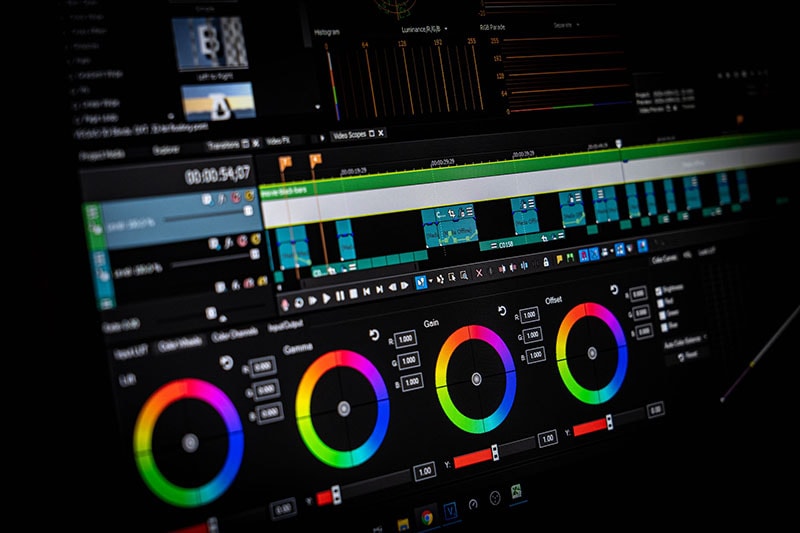
Video clips are produced by a director, then edited. The objective is to quickly communicate a story while holding the audience’s attention. In conclusion, video editing is the process of assembling the most relevant clips into a coherent order.
With that said, let’s get started!
1. Select a genre
Numerous genres are constantly developing in the realm of videography. So, if you’ve ever wanted to work as a video editor, I suggest editing the kinds of videos you enjoy. A skilled video editor is necessary for every type of video. To edit cinematics, for example, no one employs a film editor. Therefore, choosing the ideal genre for you should be your first step. And you should only diversify your repertoire when you have mastered one.
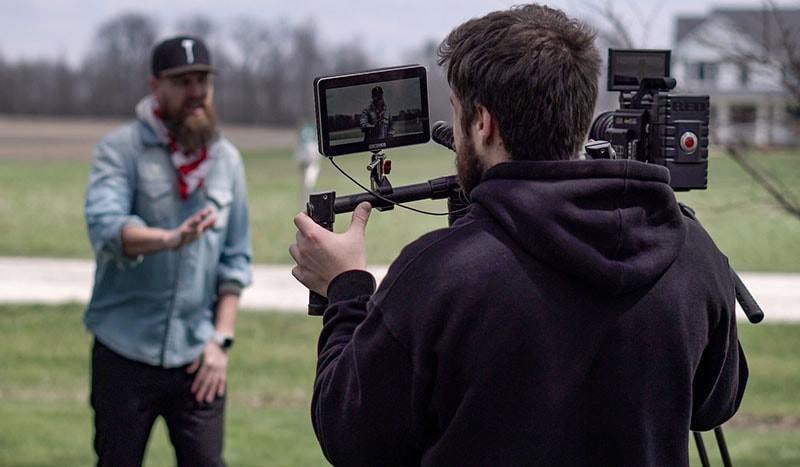
You must maintain an open mind if you want to succeed as a video editor. Every day, new methods and technologies are created. As a result, you should try to improve your talents while also keeping an eye on current trends. You’re aware that perfect practice makes perfect. And in the creative industries, this statement is crucial. In order to improve your talents, pick the appropriate tools and progress from easy to complex tasks.
Making the most of every chance is essential if you want to become a professional video editor. In this regard, picking the appropriate genre is just as crucial as the task at hand. Today, the majority of businesses search online for potential applicants. You can apply on employment portals and join online communities. Don’t undervalue the importance of having strong ties. Performing independent work makes it easier to network with others in the field. After all, networking with other editors will improve your own video editing skills. Furthermore, developing a strong portfolio and resume will increase your chances of landing a job.
2. Create a portfolio
Your greatest work is shown in your video editor portfolio, which also facilitates contact with potential clients and employers. Before you start, look through the portfolios of other video editors to understand what works and what can make you stand out. Next take the following actions to develop your digital portfolio:
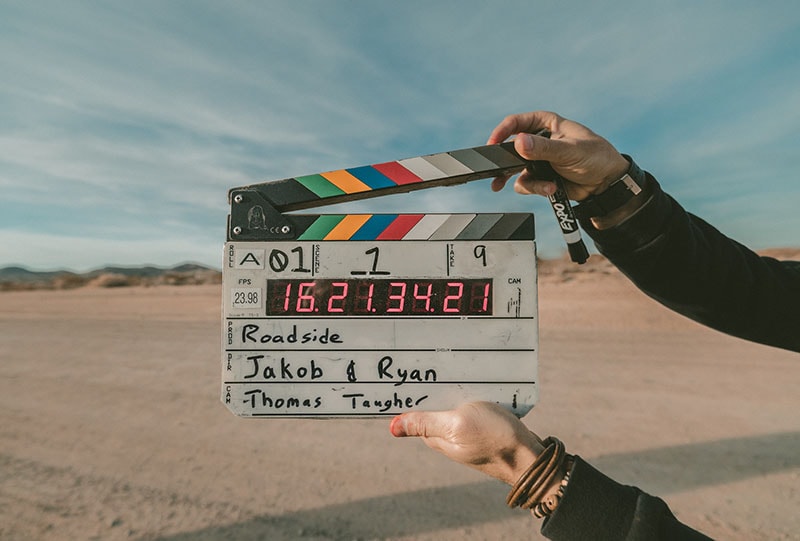
Select a platform
To showcase your editing skills, choose a professional video portfolio hosting provider like YouTube or Vimeo or build a personal website.
Identify yourself
Include a powerful biography about your work and yourself, as well as links to your social media profiles, phone number, and resume as a video editor. Add any honors or certifications you’ve received as well.
Display your work
To show your versatility and depth, including a variety of video types: Start with B-rolls, stock footage, video reels, and montages. Make sure the work is of a high caliber and showcases your varied abilities and distinctive flair. Include a brief summary of each video so that viewers can learn more about your efforts and workflow.
Include calls to action Viewer engagement with your material can be increased by using CTAs like “watch this” or “click here for the entire video”
Submit a portfolio
If no one sees it, even the most visually appealing supercut of video shorts won’t generate interest. Share your video editor portfolio on social media and invite your friends, family, and coworkers to look at it.
Prior to looking for your future employment, make sure to identify your hobbies. The easiest way to determine what you are seeking as an editor is to view a wide range of content and first consider what makes the job effective (or not). Afterward, start to eliminate options depending on your tastes as an editor and creative. You’ll do your best work on initiatives that are close to your heart or, at the very least, spark your artistic curiosity.
Consider it out: If you’re interested in narrative work, try filming your own material and putting it together in an editing program. Or work on a student movie and gain experience among other budding artists.
3. How much do video editors get paid?
The 21st century has seen an increase in the pay of movie and video editors. Online instructional videos, the production of DVDs by movie studios, and software-assisted scene editing are all on the rise.
Professionals typically get promoted with each project because most of them operate on a per-project basis. They make money while working for news organizations, businesses, or the entertainment industry. According to the US Bureau of Labor Statistics, the average yearly compensation for video editors is close to $59,500. A video editor’s typical hourly wage might be $40. (in the US). A professional editor can earn $80,000 annually, compared to a fresher who can make up to $40,000.
However, for independent contractors, the hourly wage may change. It might be anything between $14 and $80 per hour. It depends on the type of editing and the client’s budget. The typical freelancer makes $25 per hour in earnings. An hourly wage for a film editor often ranges from $20 to $40. In the United States, 59,300 video editors were working in 2016. A video or film’s final draft is heavily influenced by its video editors.
As a result, the businesses rely on them for a variety of duties like color adjustments, cut sequences, screen film, special effects, and sound insertion.
4. Know Your Software
There are several options to study video editing, including classes, university programs, and online training, whether you wish to do it for fun, a side job, or a career move. Given that the video editing sector is expected to expand over the next few years, now is a fantastic moment to enter the field. Here are a few methods for getting started with video editing:
Online classes and tutorials
There are free online lessons that may show you how to maneuver through the workspaces of video editing software, including how to create an interface, manage media, and trim footage, if you’re trying to learn video editing on the side. For its digital visual effects equivalent program, look through the Premiere Pro and After Effects tutorials provided by the American Graphic Institute.
University programs
There are four-year undergraduate degrees in film and cinema accessible for students who are interested in learning video editing over the long term and in a comprehensive way. These programs frequently mix theory and principal learning with project-based learning, enabling graduates to enter the workforce with contacts and experience that will help them land positions in the industry or launch their own video editing businesses.
Core courses for degrees in video editing highlight the critical abilities required for success. A job in video editing can be specialized by taking additional electives in areas like audio editing, animation, and special effects. Professors and coworkers from prior projects can offer letters of recommendation for job applications or reviews for a business website in addition to building a strong foundation.
Independent or self-taught learning
Collecting footage, uploading the clips, and experimenting with effect sequencing and other features are other ways to learn how to use video editing software. Researching the subject and watching tutorials won’t get you very far in the field of video editing; you need to get your hands dirty. However, reading through the software’s user manual to learn about fundamental uses and shortcuts is instructive.
Additionally, advanced techniques like color grading, sound effects, and media management can be learned through tutorials, books, and blog postings. It’s always a good idea to ask industry professionals for guidance. Video editors can produce high-quality work fast and start to identify their own editing preferences and style by using the advice of experts.
The likelihood of being selected to edit a project increases with credibility and expertise. Actively looking for employment possibilities is one approach to develop your skills as a video editor. Building a diversified portfolio and demo reel for new video editors can be facilitated by submitting proposals for video editing to nearby companies or posting job bids on freelance websites.
By enrolling in courses or earning a credential in video editing, you can compete for project bids in another method. Job seekers can establish credibility and show a dedication to learning their craft by taking outside training.
5. Experience
As a video editor, education and practice go hand in hand. Naturally, you can’t begin working as a video editor without training because you first need to learn how to operate the program and comprehend the fundamental ideas and procedures involved in video editing. However, work experience is a crucial component of training because studying video editing on the job is the only way to truly understand it because it is such a collaborative process.
Therefore, you must first enroll in a formal course of some kind (there are some entirely self-taught video editors, but they remain the exception). You might want to pursue a Level 3 or Level 4 Diploma in Creative Media Production in the UK, for example, as this could be situated at a college or university. In the alternative, you could choose the flexibility an online course can provide if you are unable to afford the time and money required for full-time education.
Of course, you’d want to make sure it was a good one, and just because something is pricey doesn’t mean it’s good. If the course providers are unable to show evidence that graduates go on to obtain employment in the sector, you have your answer.
Additionally, you’ll need to learn how to use video editing software, which will definitely require some independent study even if it’s a requirement for your course. When you’re ready, you should start looking for experience anywhere you can. Although it would be ideal, most aspiring video editors will need to go elsewhere for internships, apprenticeships, and job placements. The dream would be to get a training program operated by a broadcaster like the BBC.
Sending out numerous inquiries, along with the greatest showreel you can put together, to production firms, advertising agencies, design studios, and others will probably be required to accomplish this. You will also probably have to endure numerous rejections.
It will also need that you support yourself while working a significant amount of hours for no pay. This is not ideal and severely discriminates against those from impoverished origins, much like the situation in other creative industries. However, it is regrettably the current reality in this intensely competitive profession. On the bright side, long-term perseverance should be rewarded with satisfying and artistically gratifying employment and respectable pay.
6. Spend time on networking
Few things are more annoying than attempting to expand your business network while holed up in a room with no windows for most of the day. but connecting with others who are similarly hiding in their own dark spaces!
Since “I don’t want to annoy people” is the most common objection to sending cold emails, people frequently decide to attend mixers and live events instead because the crowds are friendlier. The issue with this approach is that it relies entirely on chance encounters at these events for your network to grow. You might attend weekly mixers for the rest of your career without ever meeting your perfect mentor or editing hero.
The chances are very high that the people who could give you career advice or even mentorship are stuck in their own dark rooms, working long hours, and avoiding networking events because they too are most likely introverted, given the likelihood that the editors, assistants, etc. that you really want (i.e. NEED to connect with) are introverted.
People want to see you succeed, so believe me when I say that you can’t expect them to come to you. You need to contact them. Because they want to use their free time to give back to the community, many editors at all levels of the industry are starting mentorship sites while also earning some income along in the process.
Nobody wants to read your life narrative if they don’t know who you are, and I’m sorry to have to break it to you. Contrary to what you might believe, this is not your “ONLY chance” I know how daunting it can be to reach out in the cold to someone you like who could potentially revolutionize your career with a simple referral. As I’ve already stated, the main goal of your first email is to elicit a response, so you shouldn’t feel compelled to include everything you’ve ever wanted to say in it.
Consider for a moment what kind of outreach email you would reply to if you were your receiver. Do you want to read about someone’s entire life, no matter how intriguing it may be, in one message? Do you know how to reply even if you did want to read it? Remember that even if you’ve given this message a lot of importance and it could affect your career, this person’s life will still go on even if they disregard your email.
You need to pay attention to the format of your email in addition to being mindful of its length. With smartphones and thumb-scrolling in the digital age, we have all evolved into “skimmers” rather than “readers.” Don’t send a single long text message. Use line breaks and “flag posts” to indicate the topic of each paragraph so the reader knows what to expect from each one.
7. Get your first job
You must first realize that there are numerous ways to become an editor as well as numerous editing specializations. This indicates that there is no obvious course for you to take. This tutorial highlights the key steps you may take to take your first step toward a career in editing. To land your first junior video editing job, use one or more of these strategies:
Assistant video editor
The fact that more and more editing is being done remotely is fantastic. A digital nomad’s fantasy, indeed. Accordingly, some editors are searching for Assistant Editors (both local and remote) to assist them with their projects in every country on earth.
Find Assistant Editor positions that fit you based on your skill level, location, internet speeds, and career objectives by searching online and in forums. The numerous employment boards and recruiting websites, along with Craigslist, Facebook Groups, and membership websites like Shooting People, etc., are some good locations worth looking out.
Contact YouTube creators
A strategy that is becoming more and more popular for getting your first paid job is to approach YouTubers and offer your video editing services. This indicates fierce competitiveness. But if you discover the appropriate creator, you might appreciate the task. Be warned that there are short turnaround times and low pay. Don’t undersell yourself because there will always be someone else prepared to labor for nothing.
Network at events
All film festivals were compelled to be held online due to the COVID virus. As limitations loosened, festivals began hosting both a live event and an online one. As a result, networking is now simpler than ever before — you don’t even need to get up from your desk!
Purchase a ticket to a film festival that showcases the genre of projects you are interested in working on and use the entire event to network. Be personable, not aggressive, and put yourself out there. Additionally, you may browse Vimeo for videos you enjoy and then get in touch with the editor or director to ask about potential opportunities as an assistant. However, networking in person is much simpler. The selling is done by your personality, which is challenging to convey with language.
Use Fiverr or UpWork
This method of landing your first job has a minimal barrier to entry. The problem is that wages are pitiful, and competition is intense. This can be a possibility for you if all you want is to practice and not earn a living. To achieve a position in these marketplaces where you may earn a living, it requires a lot of effort and time. And even then, the labor is generally monotonous. Avoid starting down this road and falling into the Fiverr loop. Due to your lack of connections and lack of expertise in the areas you would genuinely like to edit, it may be challenging for you to move on and work on more intriguing projects.
These are a few methods for getting your first job in video editing. You probably expected something more specific and logical. The problem is that nowadays, a lot of individuals have a PC in their bedroom that is capable of editing videos, so you have to work hard to stand out.
If I were to start again today, I would hound all the editing and post-production companies in my city, utilizing my outgoing personality and creative applications to entice them into granting me an entry-level position.
8. The best locations for video editing
When it comes to launching a career as a video editor, some locations are preferable to others. In this case, California, New Jersey, Hawaii, and New York are the finest states to live in. In California, video editors earn an average pay of $63,678. In contrast, they would average $62,559 and $61,479, respectively, in New Jersey and Hawaii.
Even though the average salary for video editors in New York is only $60,871, this is still greater than the national average. These are the states we found to have the most jobs and the highest salaries. We reduced our list of states to these four by determining the median wage, the cost of living, and the Location Quotient from the Bureau of Labor Statistics.
Los Angeles is the first place that springs to mindink about movies. And for good cause too! In Los Angeles, countless movies are shot, and every single one of them needs to be edited. About 8,810 video editors were employed in L.A. in 2014, and their average yearly salary was $105,370.
“I believe I’ll travel to Boston. In their 2005 song, “Boston,” Augustana sings, “I think I’ll start a new life, I think I’ll start it over.” So, pack your bags and travel to the city that Matt Damon and Ben Affleck adore. Rest easy knowing that the average yearly salary for 420 editors was $54,210.
Atlanta is the new movie location that production companies are picking. Video editors have relocated to Atlanta as a result of the switch to get a taste of the industry. 330 editors in Atlanta earned around $52,300 last year.
The dense forest of lush green trees in the Pacific Northwest is ideal for productions of Portlandia and Grimm. In Portland, where there are so many shows, young video editors are advancing their careers. In Portland, 300 video editors made about $46,560 last year.
Illinois provides a 30% tax credit for all eligible productions, much like Georgia does. If you work as an editor and make above $100,000 a year, Illinois will refund 30% of your earnings. Visit InVideo online to get access to a wealth of tools and features if you’re looking for a free video editing and creating platform that produces the best results.
Places to avoid
A quick look at the website for the Nebraska Film Commission will show you that the state is not the best for filming. Even though the most recent Alexander Payne movie was filmed in this state, its filmography is still quite little.
Mount Rushmore and the worst film commission website in history are both located in South Dakota. South Dakota makes up for its lack of a rich cinema heritage with its picturesque environment.
Idaho has beautiful countryside, but there are few chances for shooting and post-production. Since Idaho does not offer tax credits to filmmakers, many productions choose to shoot elsewhere.
Hawaii, the setting for the television shows Jurassic Park and Lost, comes in last on the list due to its high cost of living and lack of employment opportunities. A short search revealed that there are absolutely no video editing jobs available in Hawaii. It is expensive to reside in and shoot in Hawaii because a one-way ticket from Los Angeles to the islands costs $500.
9. Working in teams
It’s not always necessary to work alone when editing videos. In actuality, as the name implies, it involves the whole team. Reputable companies frequently employ a team of specialists for various aspects of video editing. You’ll probably collaborate with a group that includes sound experts, cinematographers, and special effects creators. Enhancing collaboration guarantees the timely and error-free delivery of high-quality movies. Therefore, before beginning your career as a video editor, you must master this expertise.
Videos and films are frequently filmed out of order. For instance, the final scene might be filmed in the middle of production if the weather is right. As a result, you frequently receive unstructured data. As the video editor, it is your responsibility to follow the narrative.
You can depend on the main script, so don’t worry. But being aware of what’s happening will greatly simplify your life. Keeping in mind the setup of the scene and the intended concepts for each frame, for instance. Sticky notes and a good memory ensure that you never get off track.
The Bottom Line
Due to widespread digitalization, there is a high demand for video editing skills. Several well-known businesses are embracing digital media, particularly in the midst of the recent pandemic. The market has seen a sharp increase in demand for professional video editors. As a result, I covered how to become a video editor in this article along with everything else you need know. Thanks for reading!
Free Download For Win 7 or later(64-bit)
Free Download For macOS 10.14 or later
Free Download For macOS 10.14 or later
Have You Ever Tried DaVinci Resolve for Creating a Motion Blur Effect? Read This Article to Discover How to Use DaVinci Resolve Motion Blur with the Help of Detailed Instructions
Do you want to give extra details to your object’s movements in a video? Motion blur effect can instantly add a natural effect to your videos by smoothening the lines and edges. It also adds a sense of action in a video quite dramatically.
Many professionals also say that motion blur creates a passage of time by crafting vibrant streaks of colors. So, if you want to add this dynamic effect, this article will help you. By reading this article, you can learn how to add motion blur in DaVinci Resolve using efficient ways.
Part 1: What is DaVinci Resolve?
DaVinci Resolve is an all-in-one software that includes various capabilities. Using this tool, you can effortlessly add effects, filters, visual graphics, and other elements. You can also use this professional software to color-correct your video by altering saturation, hue, contrast, and brightness. With new upgrades, DaVinci provides remote collaboration using Blackmagic Cloud. This will allow you to collaborate with multiple users efficiently.
You can find different tools on different pages of DaVinci. This flexibility and wide space will help you to execute video editing effortlessly. Furthermore, you can also create customizable keyboard shortcuts to increase your overall work efficiency. Thus, its highly professional software contains a wide range of media management, organization, and editing tools.
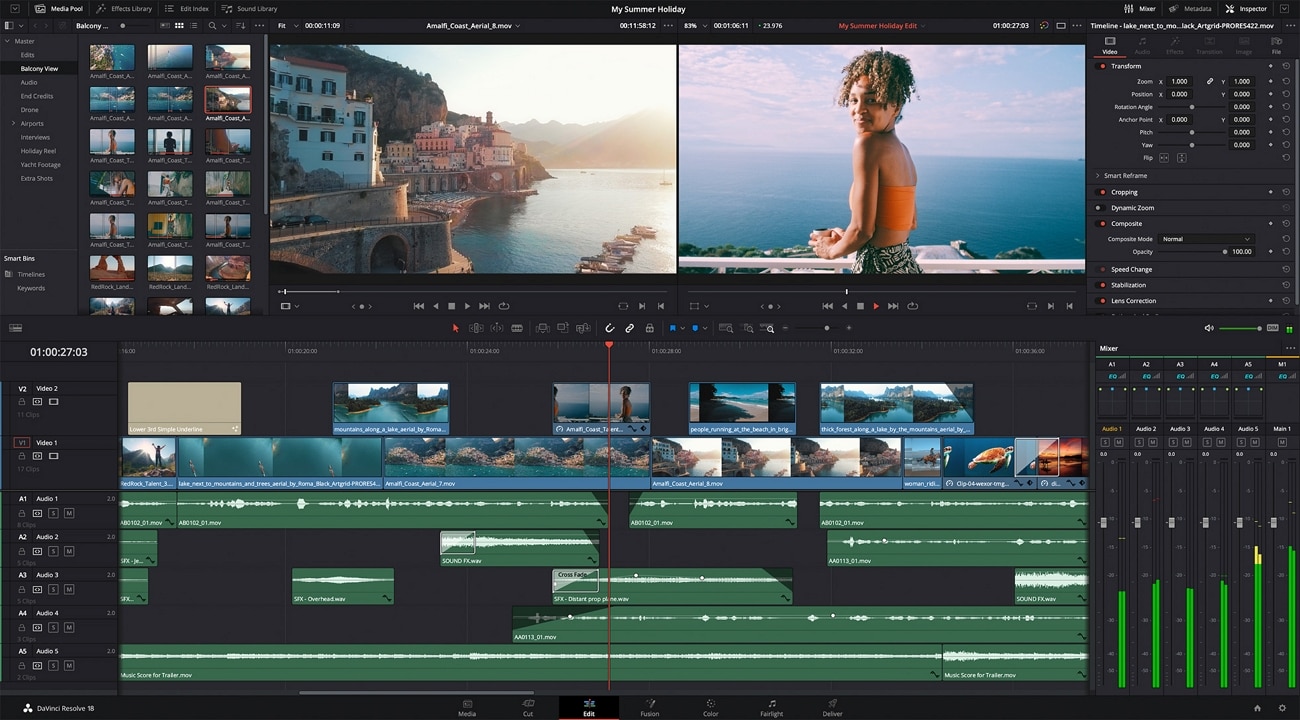
Part 2: How to Add Motion Blur to Videos in DaVinci Resolve?
DaVinci Resolve can professionally add a motion blur effect to your videos to smoothen the look. To use the DaVinci motion blur effect, there are two efficient ways. To learn about them in detail, read this part of the section carefully.
1. On the Fusion Page
DaVinci has separate pages, like the Fusion page, for different uses. If you want to learn how to add a motion blur effect on the fusion page, check the following instructions carefully.
What is the Fusion Page in DaVinci?
On the Fusion page, you can use captivating visual effects to add a new perspective to your videos. This page consists of a diverse range of motion graphics and visual effects. You can use retouching and repairing tools from the fusion page to generate a cinematic effect quickly.
So, by merging images, effects, and animations together, you can create a vibrant effect of your own efficiently. To add DaVinci Resolve motion blur on the fusion page, here are the simple steps:
Step1 Navigate to the DaVinci Resolve tool and upload your video. Now open the fusion page and press “Shift” and “Spacebar.” On the search box, type “Motion” and select “Motion Blur” from the results. After selecting it, tap on the “Add” button.
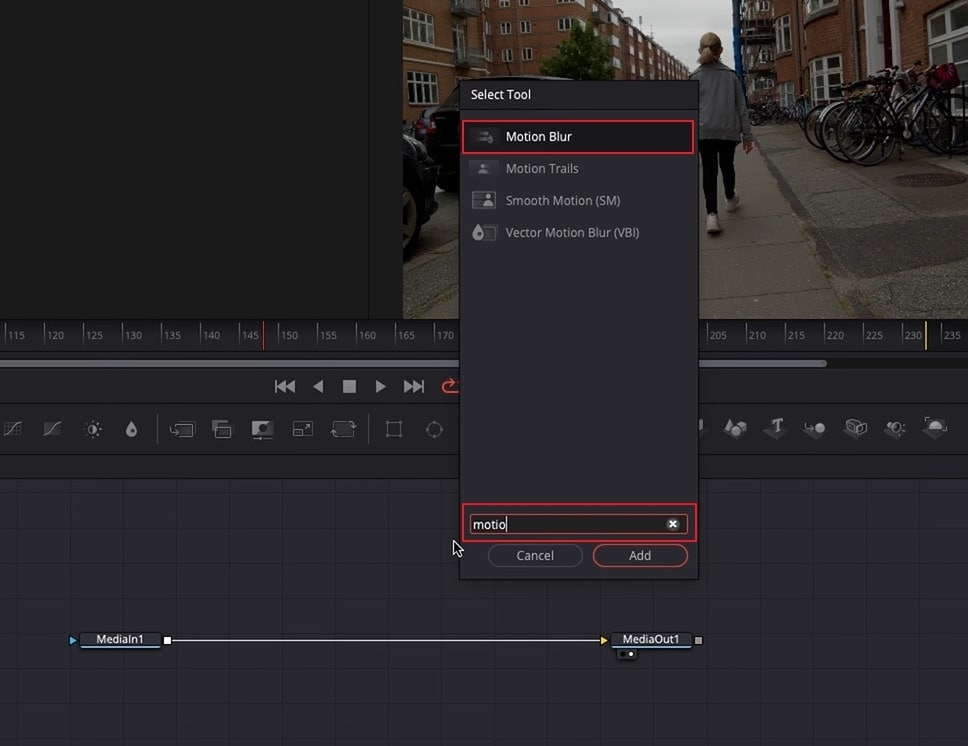
Step2 Now, you will be able to see a nod of Motion Blur on the interface. Drag this node to the center of “Media in” and “Media Out.” By selecting the motion blur node, you can adjust the settings from the right direction.
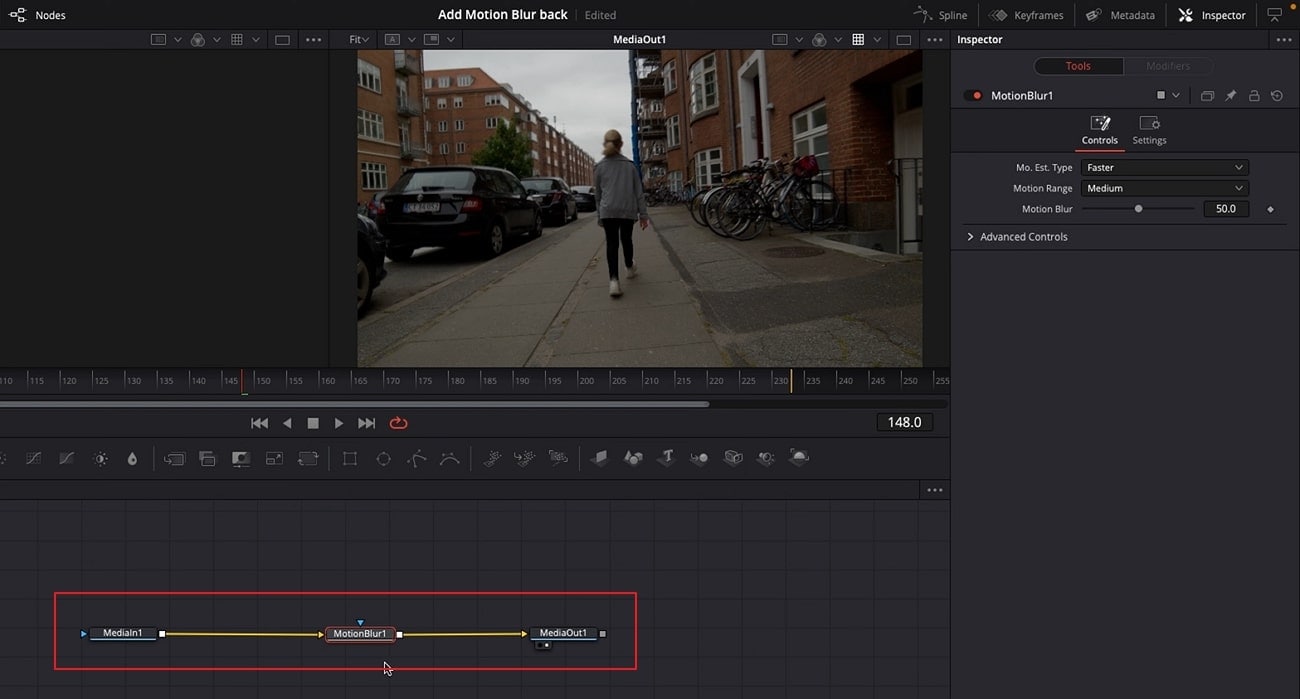
Step3 You can also remove the Motion Blur node to create more enhancements. After removing it, you have to add a “Background” and connect it to Media in and Media out nodes. Now merge the nodes and navigate to “Settings.” From the settings, you can check the box of motion blur and change its elements like quality, shutter angle, etc.
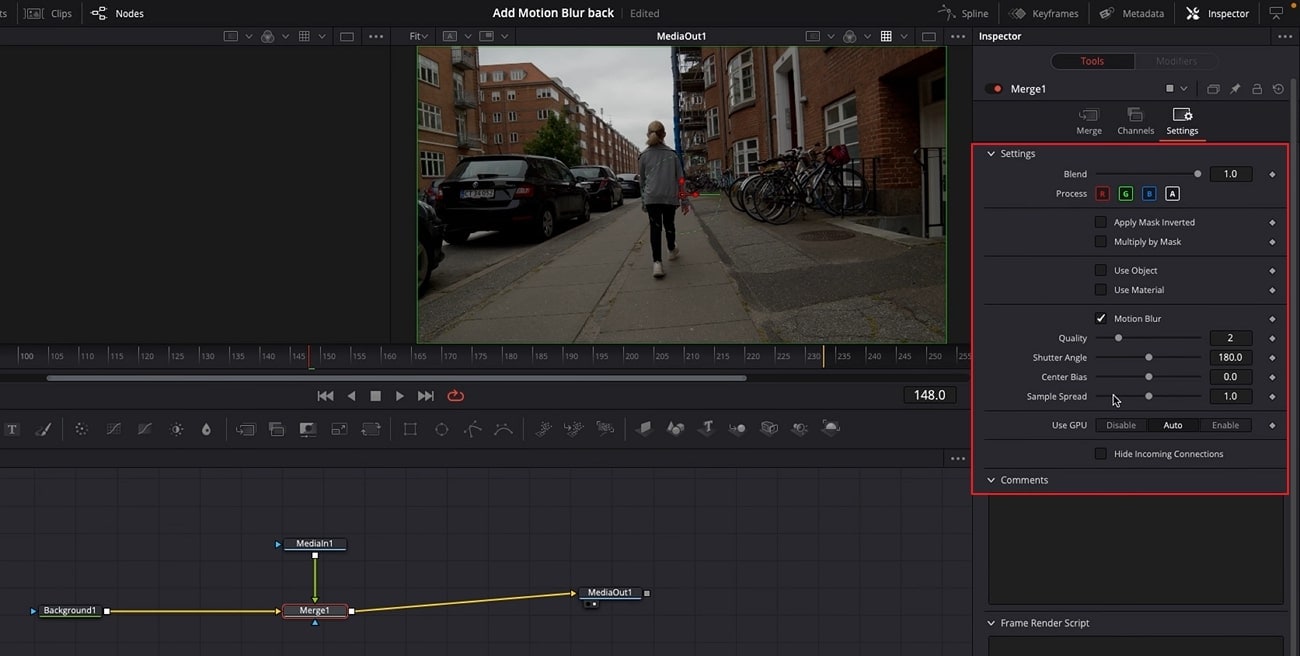
2. In the Edit Page
The Edit page in DaVinci Resolve provides you with complete freedom to add transitions, titles, and effects to the videos. On this page, you can replace, insert, overwrite and trim the clip effectively. Moreover, you can also add 2D and 3D titles to your videos on the edit page.
If you want to add a motion blur effect on DaVinci Resolve 17, you can instantly increase your work efficiency. The reason is that on DaVinci, you would be able to directly drag the motion blur effect on the editing area. Thus, it can increase your editing speed drastically. To add DaVinci motion blur on the editing page, read the below steps:
Step1 After accessing the DaVinci Resolve, open its edit page and upload the video. Once done, go to “Effects Library” and select “Open FX.” Now from the search bar, type “Motion Blur.” Select motion blur from the results and apply it to the timeline.

Step2 On the right side, select the “Effects” tab, and then you will be able to modify the motion range, motion blur value, and other elements.
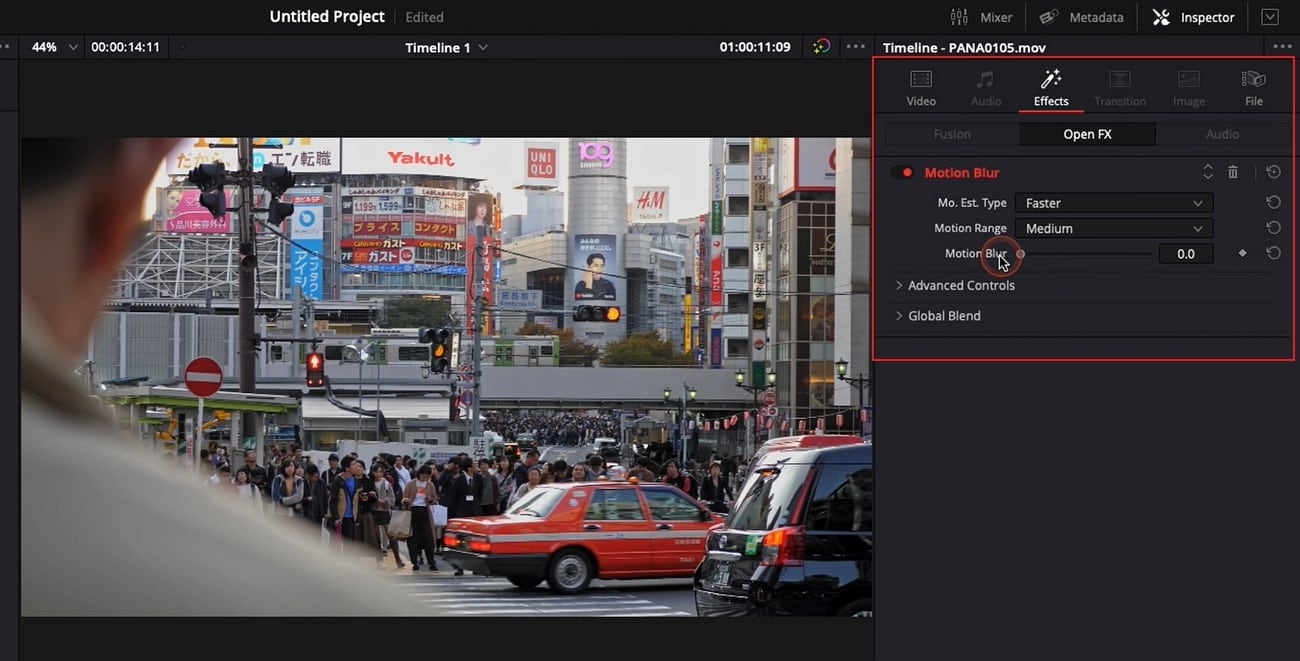
Bonus Tips – Add Motion Blur with an Alternative to DaVinci Resolve
Do you want a better tool than DaVinci Resolve motion blur? Filmora is an easy-to-use tool that has a delightful and well-designed interface. Using this tool, you can effortlessly perform flawless editing on your videos without interruption. You can transitions and effects to your video to improve their visual appeal. You can also add audio clips to the video on this platform with great ease.
Free Download For Win 7 or later(64-bit)
Free Download For macOS 10.14 or later
Apart from advanced functioning, you can also use Filmora to execute basic functions. For instance, you can cut, trim, split, merge, and crop your videos with high precision. Moreover, you can use its stock footage to create a dynamic video from scratch. Hence, it’s a complete professional software that can change the outlook of your video efficiently.
Steps to Add Motion Blur in Wondershare Filmora
Follow the steps described below to add the motion blur to your videos if you are a beginner in the video industry:
Step1 Create a New Filmora Project
After launching Filmora, hit the “Create New Project” button to open a new interface. On the project media, upload your desired media file and then drag it to the timeline.
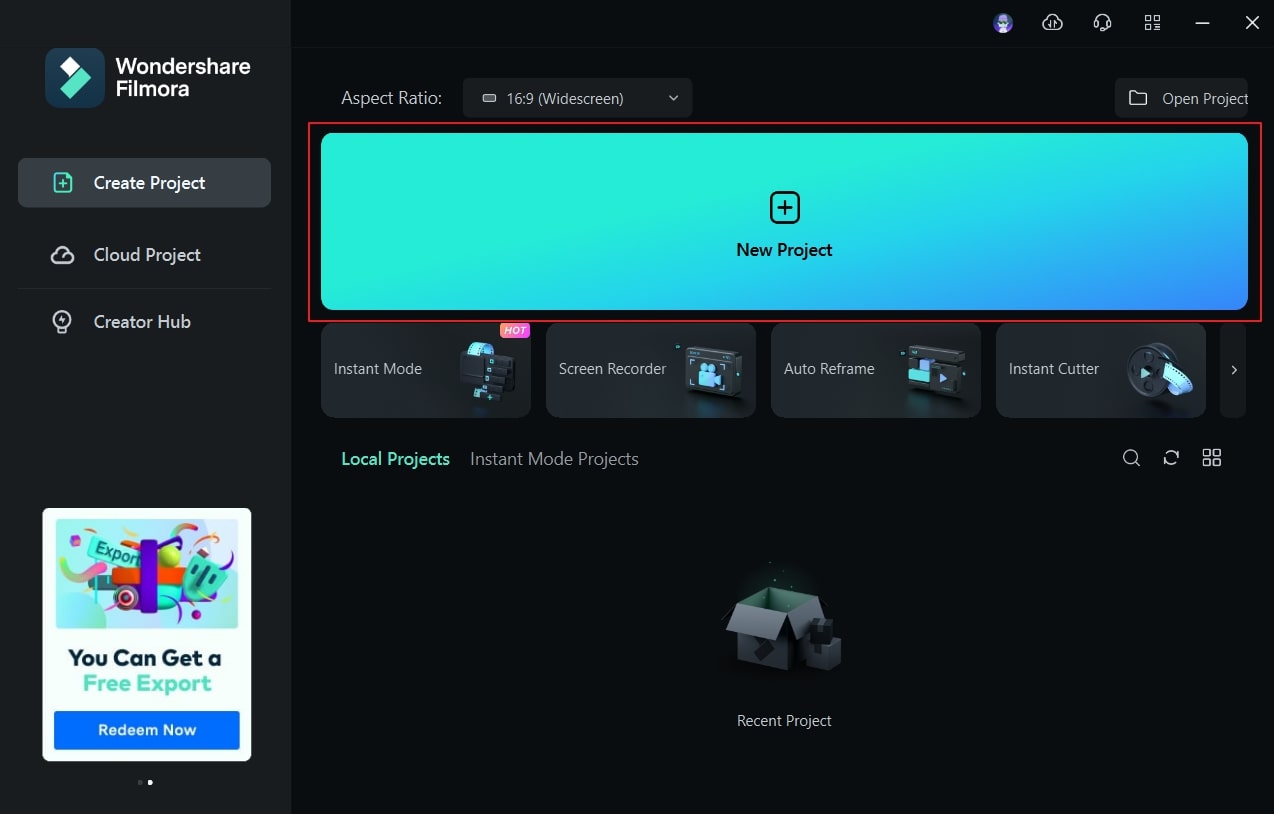
Step2 Choose the Motion Blur Effect
Now go to the “Effects” tab and select the “Video Effects” category from the left panel. Now you will have to type “Blur” in the search bar to get all the blur effects of Filmora. Select your option and apply the effect to the timeline.
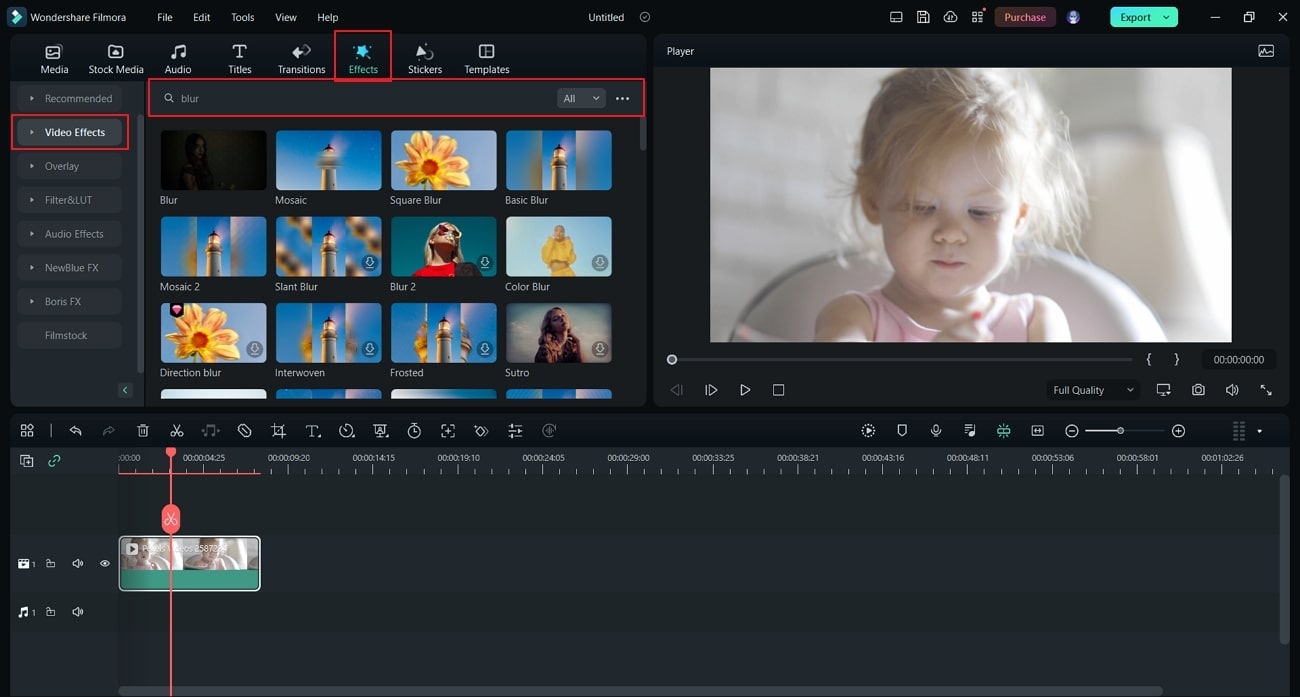
Step3 Add the Dissolve Transition
You can also add a transition known as “Dissolve” by searching for it in the “Transitions” tab to smoothen your video. You can see the final results in the preview window.
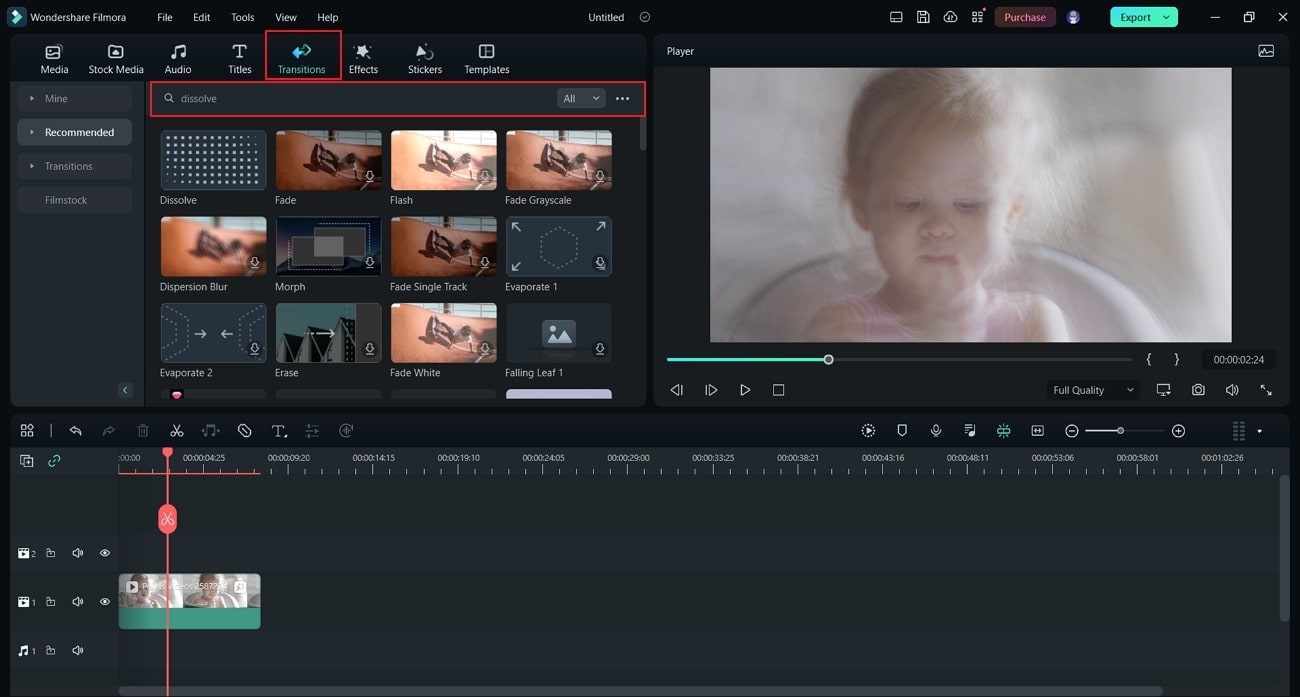
Conclusion
Have you ever added a motion blur effect to your videos? If you are unaware of how to create a professional motion blur effect, this article can provide you with complete guidance. In this article, we have used DaVinci Resolve to flawlessly add a motion blur effect. However, if you find the interface of DaVinci Resolve motion blur complicated, you can try its best alternative, Wondershare Filmora.
Free Download For macOS 10.14 or later
Apart from advanced functioning, you can also use Filmora to execute basic functions. For instance, you can cut, trim, split, merge, and crop your videos with high precision. Moreover, you can use its stock footage to create a dynamic video from scratch. Hence, it’s a complete professional software that can change the outlook of your video efficiently.
Steps to Add Motion Blur in Wondershare Filmora
Follow the steps described below to add the motion blur to your videos if you are a beginner in the video industry:
Step1 Create a New Filmora Project
After launching Filmora, hit the “Create New Project” button to open a new interface. On the project media, upload your desired media file and then drag it to the timeline.

Step2 Choose the Motion Blur Effect
Now go to the “Effects” tab and select the “Video Effects” category from the left panel. Now you will have to type “Blur” in the search bar to get all the blur effects of Filmora. Select your option and apply the effect to the timeline.

Step3 Add the Dissolve Transition
You can also add a transition known as “Dissolve” by searching for it in the “Transitions” tab to smoothen your video. You can see the final results in the preview window.

Conclusion
Have you ever added a motion blur effect to your videos? If you are unaware of how to create a professional motion blur effect, this article can provide you with complete guidance. In this article, we have used DaVinci Resolve to flawlessly add a motion blur effect. However, if you find the interface of DaVinci Resolve motion blur complicated, you can try its best alternative, Wondershare Filmora.
Also read:
- New Overview About Supported iPhone Video Formats and Best iPhone Video Editor & Converter
- Updated Using Track Matte and Tracking in Adobe After Effects Reviewing All Possibilities for 2024
- A Comprehensive Guide to Slow Motion YouTube Videos and How to Manage Them for 2024
- New How to Add a Spooky Shadow Effect for 2024
- Split Audio From Video in Adobe Premiere Pro Step by Step for 2024
- New AI Features of Filmora - Silence Detection in Videos
- 2024 Approved Discover the Top 5 Free Online Video Filter Editors to Transform Your Videos with Captivating Color Grading and Correction Presets. Elevate Your Digital Storytelling Effortlessly
- Creating Flawless Slow-Motion Videos Is Every Content Creators Dream. Learn About DaVinci Resolve Slow-Motion Video Creation, Amongst Other Tools
- In 2024, Cropping Videos in Final Cut Pro Step by Step
- In 2024, Discord Is the Future of Networking. After All, It Is Here to Stay. Have You Heard of the Discord Animated Avatar? If Yes, You Understand Its Power and if Not, Ensure You Study This Article for More Information
- New 2024 Approved Read This Article to Learn How to Convert Your Slow-Motion Videos Into Normal-Speed Videos in a Few Simple Steps and Methods. So, Stick to the End
- Updated In 2024, If You Want to Add an Effect Like a VHS Overlay Free Effect to Enhance Your Videos, You Can Do It on After Effects. Read More to Learn How
- New 2024 Approved How To Export Video in Filmora
- New How to Add Effects in Premiere Pro for 2024
- 2024 Approved How to Make Vintage Film Effect 1950S
- Updated In 2024, A Guide to Understanding Efectum App and Some Top Alternatives
- Updated Easy Steps to Loop YouTube Videos on iPhone for 2024
- 2024 Approved Learn How to Create a Unique Repeated Text Animation in the Filmora Video Editor. Follow the Simple Step-by-Step Instructions
- New Unleash the Power of Video Scopes in Your Video Editing Projects. Find the Most Common Video Scopes and How to Use Them on Video Editing Software
- In 2024, How to Add Transitions in Adobe Premiere Pro
- New How to Merge Audio and Video Using FFmpeg
- Updated Learn How to Create Animated Titles and Text in the Filmora Video Editor. This Is a Simple Step-by-Step Tutorial for Any Skill Level
- New 2024 Approved Tips & Tricks To Perfectly Use the Audio Mixer in Filmora
- 2024 Approved Efficient Ways to Change Slow Motion Video to Normal on iPhone
- Updated In 2024, How to Make a Slideshow with Icecream Slideshow Maker
- Updated 2024 Approved Exploring Tools to Integrate Special Mask Effects Into Your Content. Read the Following Article to Master some Tools Experts in Mask Tracking
- New 2024 Approved KineMaster Templates 101 How to Get the Most Out of Video Templates
- Updated 2024 Approved An Ultimate Guide to Edit a Music Video Aspect Ratio and First Cut
- Discover How to Download Mobile Phone Green Screen Videos and Pictures for Free. Elevate Your Content with HD Quality Green Screen Frames
- 2024 Approved How To Use Virtual Green Screen to Shoot Video
- Detailed Tutorial to Rotate a Video in Cyberlink PowerDirector
- New Ideas That Will Help You Out in Making Transparent Image for 2024
- How To Edit Youtube Videos In Easy Steps
- New How to Easily Add VHS Green Screen to Your Video
- In 2024, Mask Tracking Is Believed to Be a Helpful Procedure for Marking Proper Areas in Videos. Learn How to Perform Premiere Pro Mask Tracking in This Guide
- Using VN Editor To Add Luts for Video Editing for 2024
- With This Article, We Will Be Looking at Steps to Rotate a Video in Cyberlink PowerDirector to Help You when Required. We Have Also Mentioned the Steps You Will Need to Follow in Wondershare Filmora
- 2024 Approved Funny Content Ideas for YouTube Videos
- Updated How to Create a Bokeh Effect for 2024
- New 2024 Approved Discovering The Best Wedding LUTs for Premiere Pro | An Overview
- Updated To Know How to Add Effects in Premiere Pro, You Need to Follow This Guide as It Has All You Need to Know to Add Effects in Premiere Pro. Learn More Here for 2024
- New 2024 Approved Complete Guide to Change Video Resolution in Filmora
- New 2024 Approved A Detailed Guid to Remove Background From a Video in Premier Pro
- New In 2024, Detailed Steps to Rotate Videos in Blender
- Top 5 Car Locator Apps for Oppo Find X6 Pro | Dr.fone
- In 2024, How to Change Location On Facebook Dating for your Oppo Reno 8T 5G | Dr.fone
- In 2024, How to Migrate Android Data From Samsung Galaxy F04 to New Android Phone? | Dr.fone
- In 2024, A Comprehensive Guide to iCloud Unlock On Apple iPhone 14 Pro Max Online
- 3 Things You Must Know about Fake Snapchat Location On Motorola Defy 2 | Dr.fone
- In 2024, 5 Ways to Move Contacts From ZTE Nubia Z60 Ultra to iPhone (13/14/15) | Dr.fone
- Is Your iPhone 14 Plus in Security Lockout? Proper Ways To Unlock | Dr.fone
- Here are Some of the Best Pokemon Discord Servers to Join On Nokia C02 | Dr.fone
- Three Solutions to Hard Reset Oppo A1x 5G? | Dr.fone
- In 2024, Top IMEI Unlokers for Your Asus ROG Phone 7 Phone
- How to Simulate GPS Movement in AR games On Realme 12 Pro+ 5G? | Dr.fone
- All You Need To Know About Mega Greninja For OnePlus Nord 3 5G | Dr.fone
- How to Exit Android Factory Mode On Lava Yuva 3 Pro? | Dr.fone
- In 2024, Dose Life360 Notify Me When Someone Checks My Location On Vivo S18e? | Dr.fone
- In 2024, Unlock Apple iPhone 6s With Forgotten Passcode Different Methods You Can Try | Dr.fone
- Dose Life360 Notify Me When Someone Checks My Location On Infinix Smart 7? | Dr.fone
- What You Want To Know About Two-Factor Authentication for iCloud From your iPhone 11 Pro
- In 2024, How to Remove iPhone SE SIM Lock?
- In 2024, Forgot Locked iPhone 6s Plus Password? Learn the Best Methods To Unlock
- In 2024, How to Get and Use Pokemon Go Promo Codes On Apple iPhone 6 | Dr.fone
- Simple ways to get recent calls back from Nokia C110
- In 2024, What Is a SIM Network Unlock PIN? Get Your Vivo X Flip Phone Network-Ready
- In 2024, A Step-by-Step Guide on Using ADB and Fastboot to Remove FRP Lock from your Gionee
- Set Your Preferred Job Location on LinkedIn App of your Nokia XR21 | Dr.fone
- Android Unlock Code Sim Unlock Your Google Phone and Remove Locked Screen
- How to Repair a Damaged video file of Xiaomi 14 using Video Repair Utility on Mac?
- List of Pokémon Go Joysticks On Realme Narzo N55 | Dr.fone
- Top 9 Vivo V29 Monitoring Apps for Parental Controls | Dr.fone
- Full Guide to Fix iToolab AnyGO Not Working On Lenovo ThinkPhone | Dr.fone
- In 2024, List of Pokémon Go Joysticks On Apple iPhone X | Dr.fone
- How To Restore Missing Pictures Files from Motorola Edge 40.
- 3 Ways to Export Contacts from Apple iPhone XS Max to Excel CSV & vCard Easily | Dr.fone
- How to Make an Adorable Video for Your Babys First Year for 2024
- How to Fix Android.Process.Media Has Stopped on Vivo Y100i | Dr.fone
- In 2024, Ultimate Guide on Xiaomi Redmi Note 13 5G FRP Bypass
- Title: Learn Everything About Leeming LUT Pro
- Author: Morgan
- Created at : 2024-05-19 05:11:39
- Updated at : 2024-05-20 05:11:39
- Link: https://ai-video-editing.techidaily.com/learn-everything-about-leeming-lut-pro/
- License: This work is licensed under CC BY-NC-SA 4.0.

